October 2007 archives
you are here [x]: Scarlet Star Studios > the Scarlet Letters > October 2007
<< before
September 2007
after >>
November 2007
October 31, 2007
happy halloween from scarlet star studios!
by gl. at 11:29 am

posted by gl. | permalink | categories: miscellany
R.I.P. Professor Ichbonnsen
by sven at 11:29 am
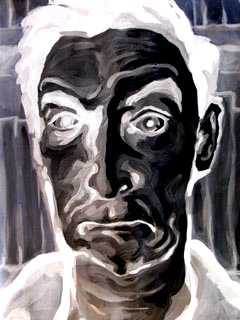
I'm stunned... Professor Ichbonnsen, my eccentric employer -- is dead!
Apparently he died from being bitten by the venomous "Amazon Dragon." His intern Scarlet (no relation to this blog) posted the announcement earlier this morning.
When Ichbonnsen first contacted me, I was incredulous.
When my friend Mike declared that Ichbonnsen was a fraud -- and the Professor started getting argumentative -- I was dismayed.
However, as time passed and I began checking out some of the Prof's stories, I became increasingly impressed with the science behind Monster Month. If everything that he said was false, then this is one of the most elaborate and well-researched hoaxes I've ever encountered.
When I agreed to illustrate monsters for him, I thought that he was just going to send me descriptions to work from... But no! He would send me photographs (admittedly blurry), his own sketches, accounts from other witnesses -- and even the occasional sound recording.
The way in which he delivered this evidence was also compelling...
Folks who only read the Scarlet Letters blog may not even be aware of what all was going on this month. All through October, Ichbonnsen and Scarlet were traveling around the world... So in addition to posting my paintings on the Monster Month blog, they were writing up stories about the exotic locales they visited, and the adventures wherein several new monsters were discovered.
Often this meant that I had very little turn-around time between when they gave me an assignment and when it was due. I can't really complain, though -- I feel like my skills in working with acrylics really bloomed. And that, after all, was one of my main goals when I signed-on.
I don't what I should do. I never met Ichbonnsen face-to-face. Yet, via email, we worked really intensely together. How to I measure that loss? What's an appropriate memorial?
Regardless of where the line between truth and fiction lies, I've developed a strong respect for the man. Here was someone who could hold onto his convictions tenaciously -- even in the face of near universal opposition.
Call it crazy if you will -- but still, that's a rare form of bravery.
Rest in peace, Ichbonnsen.
posted by sven | permalink | categories: bestiary
From Brazil: The Amazon Dragon
by sven at 8:00 am
These are the Professor's words -- but they were posted by Scarlet?
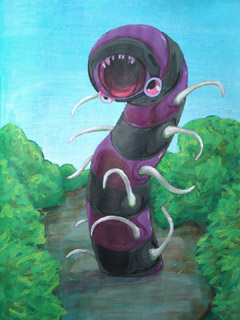
We are all familiar with the image of dragons as giant fire-breathing lizards with wings. The Amazon Dragon, however, is closer to the Medieval image of dragons as wyrms. That is to say, this creature is actually a monumental worm.
The "Dragon" was discovered by a Portuguese soldier circa 1600, deep in the Amazon jungle. From what I've been able to piece together, the animal was approximately 100 yards long. Its body is banded with alternating purple and black rings. It has rows of gray snake-like legs on either side -- rather like a millipede. Its face has been likened to that of a fish.
The creature seems to be amphibious. According to the soldier, it rises out of a river and breathes air -- then dives back beneath the surface.
I am in possession of a map -- drawn by the soldier himself -- that purportedly leads to the Amazon Dragon's lair. Comparing it with recent geological surveys, I think there is good reason to believe that there will be underwater caves in this area... Which would help explain how the great beast has remained hidden for so long.
Over the past four centuries there have been several further sightings of the Dragon. Each time, the size is reported as being significantly smaller than it was previously. The last sighting, in 1910, put the creature at a length of only 30 yards.
Is it shrinking?
posted by sven | permalink | categories: bestiary
October 30, 2007
Z - The Zompire Bat
by sven at 8:00 am
Reprinted with permission from Professor Ichbonnsen's Monster Month blog.
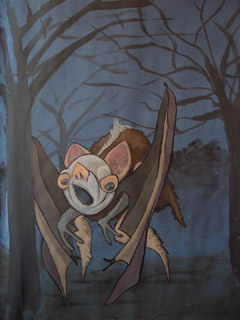
The Zompire Bat is a large South American carnivore related to the Vampire Bat. It stands about five feet tall and is found primarily in Argentina.
The bat's wingspan is approximately 20 feet -- however, it is too heavy to actually fly. It uses its wings instead to corral and capture prey, wrapping them in a deadly embrace.
The creature kills and eats large game: cattle, wild pigs -- and humans who are unwary. It is extremely messy, rending flesh, mangling the bodies of its victims... It actually only drinks their blood; the purpose of this behavior seems to be simply to create a good flow.
Zompire bats have very poor eyesight and are uncoordinated moving on the ground -- stumbling and dragging themselves about. When they hunt, they depend upon the element of surprise.
The bat digs a shallow hole and covers itself with dirt. When it senses that prey is near, it bursts from the ground -- imparting a sort of "dead rising from the grave" appearance. The wings trap its food, its powerful jaws clamp down, and the bat thrashes its head until blood is gushing everywhere.
Like other bats, Zompires use echolocation. However, whereas most species use high or even ultrasonic pitches, this creature uses subsonics (much as crocodiles do). The system only works effectively underground -- where perception extends in a 2 mile radius. Above ground, the portion of the call that is audible to humans sounds like hideous groaning and moaning.
Newborn bats are birthed directly into holes, where they are left to mature for several months. The bats seem most comfortable underground, and spend most of their lives hidden there. Wrapped in its own wings, a Zompire Bat looks quite like a large black seed pod or coffin.
It should be noted that the safest time to study the Zompire Bat is when it is hibernating during the winter months. It can be exhumed and examined for a brief period -- but under no circumstances should it be allowed to warm up. Dire consequences follow.
posted by sven | permalink | categories: bestiary
October 29, 2007
Y - The Yellow Riders
by sven at 8:00 am
Reprinted with permission from Professor Ichbonnsen's Monster Month blog.
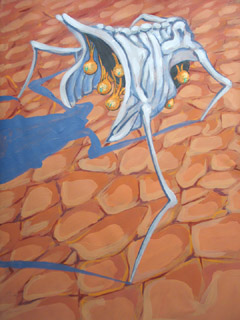
Traveling in Australia, I met an old Gunwinggu man in the Northern Territory who told a strange tale. He reported seeing "little yellow people riding a dead man" some years ago. After weeks of fruitless searching, I finally did get a brief glimpse of the thing he described.
I was camped in the Simpson desert. Just after dawn, I woke to the sound of something rummaging through my provisions -- and there it was.
The creature looks much like a bleached human skeleton. One could easily believe that the emaciated thing is nothing but bones -- but it is covered by skin. It is headless, and moves on all fours. It doesn't have hands or feet, but rather insect-like points at the ends of its limbs. I was unable to see any sensory organs.
The ribcage is not closed; it hangs wide open, and is perhaps three feet wide. A large green-black sack hangs from the interior. I presume this is where the vital organs reside. It is also where the Yellow Riders dangle.
The Yellow Riders are small almost-spherical creatures with bright green eyes. There were perhaps fifteen attached to the skeletal being's ventral sack by sinewy roots.
As I came out of my pup tent, the Riders seemed to take notice -- making squeaky sounds and bobbing up and down. Their white mount took off at a gallop.
I leapt into my jeep and chased them across a field of cracking dried red mud... But the creatures quickly outpaced me -- meaning that the white thing can run at speeds in excess of 80 miles per hour.
I have no explanation for what this thing that I encountered might be. It seems likely that the Yellow Riders have a symbiotic relationship with the galloping creature... All I can say for certain, though, is that it likes peanut butter.
posted by sven | permalink | categories: bestiary
October 28, 2007
artist's way: session 5
by gl. at 11:13 pm
things are starting to get harder for the group: this was the first week where some of them said they didn't want to show up. but they DID! showing up is a huge part of the equation, and once they were here, they were heard, and they could get to making art, they relaxed. you could see the weight release from them as they focused on blind contour drawing, the art activity of the day. they breathed easier, they smiled, and their checkins at the end of the session were much calmer than they were at the beginning.
it takes courage to be the first person to admit to the group that you're having a bad week. the weeks have flown by and they've been busy bonding, but it's not unexpected to see what julia calls "creative u-turns," where the rest of their lives have not gone as smoothly as the artist's way and are beginning to interrupt and disrupt their progress. all i ask is that they keep showing up. awareness leads to progress.
blind contour drawings start by drawing an object (in this case, two objects because the group is so large: edward gorey's bah humbug & a stuffed bat michaelmas gave me). then they're ready to do self-portraits holding mirrors. then i ask them to draw each other, which means i drag out the large insulation panels to give us more "wall" where the windows are. it's always amazing to me how much insight blind contours drawings give you: when an artist's hands, heart & head are all working in harmony, you really get a chance to see what the artist sees. and when you are drawing each other, it is odd and intense for someone to look at you for an extended period of time. many of them used the word "intimate" when writing about it afterwards, but they also appreciated the opportunity to see and be seen.
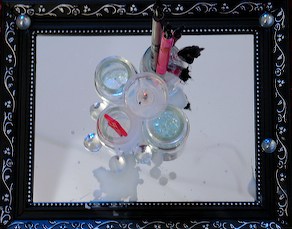
center (integrity/possibility): we doubled up on chapters this week, a consequence of shortening the cluster. here we have four glass jars on a mirror, reflecting into infinity. each jar has some sort of unknowable thing in it: tiny glass beads, marbles, a red star, pens & brushes. a candle was set atop. you're seeing it here after i've just dropped something onto the center, splattering wax everywhere.
music: the piano, which worked out well last year as a dramatic "first thing you hear upon the end of media deprivation" album, but this time it just seemed fussy.
posted by gl. | permalink | categories: artist's way
X - The Xem
by sven at 9:00 pm
Reprinted with permission from Professor Ichbonnsen's Monster Month blog.
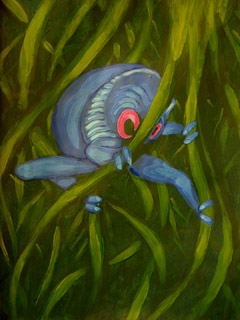
The Xem is a small subterranean creature, about the size of a hat. It feeds on rotting tree roots between 4 and 20 feet underground.
It has a coat of short fur and a small mane around its head -- all of which is dingy black-brown. However, under black light the creature fluoresces a brilliant blue. This makes it much easier to spot, if one is using a sub-surface periscope.
The Xem has four two-fingered limbs and no tail. It is slow-moving, but sure-footed. The round head has two enormous eyes, but no nose or mouth for breathing. Its metabolism is almost entirely anaerobic.
The Xem's jaws are located in its midsection. The creature's ribcage is hinged at the spine; it has rows of tiny teeth where most animals would have a sternum. As the body swells and contracts, chewing is easily mistaken for breathing.
Xems live in small colonies of a dozen or so creatures, which move through underground tunnels between the trees that they depend upon for food. The adult Xem's fingers are not suited for digging; all of the tunnel systems are created by the young.
Infants are born in litters of 30 or more. At birth, the creatures have tough webbing between their fingers, ideal for excavation. Unlike their slow-moving elders, the young move about at a rapid pace, carving out living spaces for the next generation.
For unknown reasons, Xems have extremely high infant mortality rates: almost 90% of the young die within a month of birth. The bodies are transported to the lowest room in a tunnel system and left in piles to decay.
The sacrifice of the young does seem to serve an evolutionary purpose: many workers are needed to create living spaces -- but there are not enough tree roots to support such a large population. It has been speculated that a minority of Xems are born with a slower metabolism -- and that these ones are the few who survive into adulthood, while the rest simply burn out.
posted by sven | permalink | categories: bestiary
October 27, 2007
From Desolation Island: The Kerguelen Zorn
by sven at 9:45 pm
Reprinted with permission from Professor Ichbonnsen's Monster Month blog.
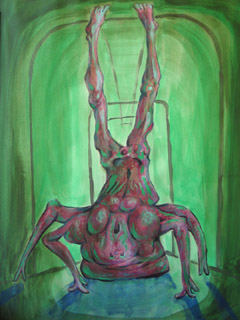
Little is known for certain about the Kerguelen Zorn. My belief is that it is a human mutation induced by viral infection.
The creature in question was clearly human to begin with. Evidence suggests that the transformation from man to zorn can take up to two weeks. In some cases, however, it occurs in a single day.
The infected person's skin becomes dark magenta -- as if it has been boiled. The head and torso become filled with fluid. The face and neck become so distended, they practically disappear.
Having become massively top-heavy, the organism inverts --- it drags its former head on the ground, and its legs stick straight up in the air. It appears that rigor mortis takes over in the legs... They become stiff, and much of their color drains away. The arms each split into two new limbs. Separation begins between the ulna and radius; one of the new limbs will have two fingers -- the other will have two fingers and a thumb.
The creature, now with four lower limbs, walks somewhat like a spider -- but dragging its slippery, sagging mass along on the floor. It is apparently blind, and finds its way by frantic, groping touch. In a low hallway, the dead legs may bump and drag above it -- almost giving the impression that the thing is walking on the ceiling.
The zorn-producing virus is highly contagious -- likely being transmitted by physical contact. My suspicion is that the virus originates from the submerged microcontinent beneath the Kerguelen Archipelago (AKA "Desolation Island"), which sunk into the ocean some 20 million years ago. I believe that an illegal oil-drilling operation recently unearthed the disease.
I have attempted to "quarantine" the virus. I hope and pray that no Kerguelen Zorns have survived.
posted by sven | permalink | categories: bestiary
October 26, 2007
W - The Whipping Molesque
by sven at 10:00 pm
Reprinted with permission from Professor Ichbonnsen's Monster Month blog.
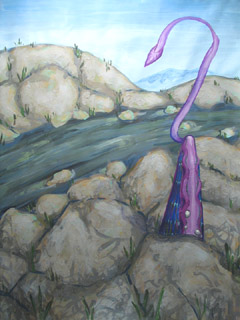
The Whipping Molesque, AKA the "Rocky Mountain Oyster," is a three-foot-tall mollusk native to the American Rocky Mountains.
The Molesque moves around using a large sucker-foot. Its shell is conical, bifurcated, and variegated with vertical blue/green ridges. When the creature is threatened, it slams shut like a bear trap, producing an echoing "snap."
The Molesque lives at the bottom of lakes, but comes onto land to hunt -- ironically for river fish. The creature sits waiting by the side of a river like a fisherman. When it senses a fish nearby, it shoots a long poison-tipped appendage into the water. The whip-like appendage paralyzes and grabs hold of the fish, retracts into the Molesque's shell, and the predator begins to digest its meal.
Like an oyster, the Molesque produces a pearl when something irritates its soft flesh. The pearls, which can be as much as a foot in diameter, would surely be worth millions if put to auction... However, if the exact location of these animals were ever revealed, it is almost equally certain that the gold rush of poachers would soon bring about their extinction.
In the name of science, and at great personal risk, I have procured and sawed open several pearls. It appears that the majority have been formed around birds, which presumably tried to eat the Molesque's flesh. One contained a human hand, severed at the wrist.
Although as yet unproven, it is my belief that Molesques go to water-filled underground cave systems to reproduce -- and that they also return there to die.
posted by sven | permalink | categories:
the portable art gallery
by sven at 3:19 pm
Gretchin is curating a "4x4" show at the All Oregon Calligraphers Conference this Saturday. I volunteered to construct a display for her for the art pieces.

I tend to like short-term intensive projects... Our main design meeting was on Friday night, I went shopping for materials Saturday, did carpentry on Sunday and Monday, painted on Tuesday, and put the finishing bits of hardware on Wednesday afternoon.
The main "wall" is 4'x4'; two hinged panels fold out, each 2' wide. We want to give the art -- all of which is 4"x4" -- lots of breathing room... So I assumed 8"x8" for each piece: 1" of "whitespace" above, 3" below, 2" on each side. That's room for 72 pieces of art, potentially.
The walls are made of .25" thick hardboard (AKA masonite). The hardboard has framing braces behind it made from .75"x1.5" pieces of poplar. Pine would have been cheaper -- but I wanted something of better quality, with fewer knots and less warping.
Looking at the calligraphy that's been submitted so far, some of it is on paper and some of it is on small canvases. Thus, it was important to have some shelves for the dimensional pieces. The shelves are .25"x2.5"x2' pieces of poplar, supported by .5"x.5"x2' rails, which attach to the frame using long screws and wing nuts (2 per shelf)
A word of advice: If you ever build a portable display that needs nuts and bolts, use wing nuts! They are sooo much easier to deal with when you're on site!
Everything that was .25" thick got assembled using 5/8" #16 wire nails. The frame was assembled with some massive wood screws for strength.
I used "black black" matte latex house paint, applied with a roller. Before this, I tried black gesso -- but felt that it smudged too much. The finish I got is very good... But I'm still wondering if enamel paint would have been more durable. The toxicity of that stuff is higher, though -- which made me loath to work with it.

The love, though, is really in the details.
People are going to walk up from the sides, so I made sure to paint the backsides of the fold-out panels as well as the frontsides that are going to display art. It looks like we're going to use clip-on lamps for lighting -- so I put hooks in back to help route the cords. Distracting light would come through the cracks where the hinges are -- so I added black canvas there as a shield (painted with acrylics for extra opaqueness).

Transporting the display is going to be a bit awkward no matter what -- but I've tried to make it as easy as possible. There's a shoulder strap in back -- not rope, but this crazy cotton ribbing (I don't know the proper word for it) that gets sewn into furniture. You put that strap over your shoulder -- and then there are side loops to grip onto for extra control. The front "doors" latch shut using the sort of latches you find on a trunk.
All told, I'm pretty darned happy with how this thing turned out. Can't wait to see it in action!
posted by sven | permalink | categories: calligraphy, exhibits & events, studio space
October 25, 2007
gregory says 'hello'
by gl. at 12:38 pm
two sundays ago i went to church of craft: i was so excited because they were making glove monsters! diane wrote more about the event on craftypod.
i brought toby with me for moral support & squee! had to come because what could be a more perfect event for a glove-based pincushion? she definitely got a lot of attention; people were very impressed with her (thanks, shelley!).

[say hello, gregory. "um... hello."]
so this is gregory, who is quite shy and looks like he's wearing a sweater. gregory doesn't say much and is mostly content to just go with the flow, which makes him a very good foil for toby, who gets him in all sort of misadventures. i thought he was going to be a vicious halloween rabbit, but when i turned him over to stuff him, i saw his "legs" as eyestalks.

[toby says, "THIS IS MY NEW BEST FRIEND!" gregory says, "um... okay."]
i had never been to the general purpose meeting room at the central library, but it's huge! it makes a great craft room and i can see lots of other possibilities, too. definitely an underrecognized resource!
posted by gl. | permalink | categories: toby
V - The Vivecta
by sven at 12:00 pm
Reprinted with permission from Professor Ichbonnsen's Monster Month blog.
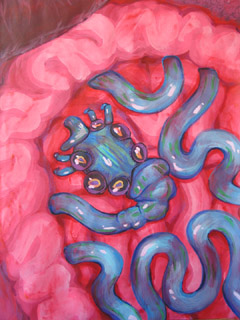
The Vivecta is a hideous intestinal parasite. It is found in The Congos, and is associated with swampy areas.
Parasitic worms typically enter the host organism orally, and then attach to the interior walls of the gastro-intestinal tract. The Vivecta is unusual in this respect; it enters its host by burrowing through the skin, and then attaches itself to the outer wall of the intestines.
At this point in its life, the Vivecta looks like a twelve-eyed, blue-green iridescent beetle. Cutting pincers at either end of the body make incisions into the intestine. Partially digested food passes from the first incision, through the Vivecta's body, and back out through the second incision into the host again.
As the parasite ages, the carapace splits in two, and a long, ropey body develops between the two "heads". Each head progressively clamps down on the intestine with four strong legs -- until the Vivecta's body completely bypasses normal digestive flow. In essence, the parasite simply becomes an extra length of intestine.
In the late stages of its development, the Vivecta can measure 20+ feet in length. In cattle and in humans, presence of the parasite is sometimes mistaken for pregnancy. Hosts are typically somewhat malnourished -- but otherwise in good health.
Reproduction is parthenogenetic. Dozens of worm-like larva develop off the hoods of the two heads. They grow quickly while in the host's body, until after a week they are approximately nine inches long. Whereas the original Vivecta passively conforms itself to the shape of the host's existing digestive tract, the infants writhe spasmodically -- which is disturbingly visible through the skin of the the host's abdomen.
The larval Vivecta leave the host en masse, first burrowing through the intestine's wall, then passing out all at once through the nether orifice. The many perforations that they make in the intestines cause severe septicaemia, which almost always results in death for the host.
There are three distinct phases in the Vivecta's life cycle. After leaving the host's body, the larvae look like black, twelve-eyed snakes. Legless, they slither outward into the environment seeking soft, wet earth in which to burrow. When they find a suitable spot, the "snakes" dig into the ground and cocoon themselves in masses of sticky fiber.
Two weeks later, the Vivecta emerge -- in the form of a small winged fly. The flies seek out warm-blooded hosts... And the life cycle begins again.
posted by sven | permalink | categories: bestiary
October 24, 2007
U - The Ubertuber
by sven at 8:00 am
Reprinted with permission from Professor Ichbonnsen's Monster Month blog.
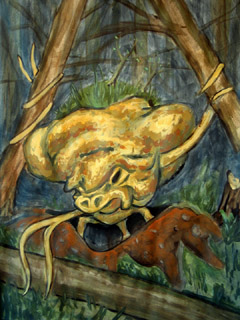
Ubertubers are currently the largest known species of sentient root. At maturity, the average plant has a mass equal to that of five elephants. Based on available data, it is believed that an Ubertuber's life-span is between 700 and 900 years.
Despite having consciousness, the tuber will spend most of its life in a vegetative state, passively absorbing nourishment from the environment. Only in times of emergency do the colossal plants become active, uprooting themselves for self-defense: e.g. when threatened by a forest fire, logging, or mining operations.
When awakened, the Ubertuber seeks immediate escape. If necessary, it is a fearsome foe -- tearing down trees and wielding them as weapons. Once it gets away from what threatens it, the plant will walk several hundred miles to find a suitable new home.
The root is semi-parasitic. It derives minerals and water from the soil -- but for certain nutrients, it taps into the trees around it. Consequently, one of the best ways to find an Ubertuber is to search a forest of great old tall trees for a patch where the trees are mysteriously shrunken and shriveled.
Ubertubers reproduce asexually by means of spores, which are released into underground streams. The reproductive cycle is usually triggered by flooding, when the water table is especially high. Given that Ubertuber populations are able to expand subterraneously, we currently have no clear idea how geographically widespread the plants are, or how many exist.
posted by sven | permalink | categories: bestiary
October 23, 2007
T - The Trick Squilligoss
by sven at 8:00 am
Reprinted with permission from Professor Ichbonnsen's Monster Month blog.

The Trick Squilligoss is a large oceanic amphibian found in the vicinity of Australia. The adult animal is between 8 and 16 feet in length. In appearance, it looks rather like a cross between a frog and a squid. It spends most of its time in deep ocean waters -- but has increasingly been sighted coming onto land.
The Squilligoss has four legs with webbed, three-toed feet. The legs have a cartilaginous skeleton that allows the creature to stand upright on land -- and also a muscular "skirt" which it can use for propelling itself underwater. There are two thin arms, which attach internally to a sort of flexible ribcage. Like squids, the creature's head has a mantle. Its beak is situated at the front of the body when swimming -- or on top of the head when it's standing. There is an air bladder on the ventral side of the head, along with two faintly bioluminescent eyes.
Normally, the Trick Squilligoss preys upon giant squid... However, due to decreasing populations of squid, the animal has increasingly been coming onto land to raid herds of cattle. Squilligosses appear in the local folklore of certain areas as a "Screaming Devil."
The Squilligoss' unearthly appearance easily "tricks" people into thinking that it is a supernatural apparition. Standing upright, the beak looks like horns. The neck bladder collapses and becomes wrinkled in a way that makes it look rather like a wide mouth with rows of long teeth. The mantle appears to be the grim cowl of a robe. Underwater, the beast emits high-pitched shrieks as a form of echolocation; on land these alien calls sound like "screaming."
The Trick Squilligoss only appears on land at night. Being most used to traveling in the murky depths of the Tasman sea, its eyes are sensitive to daytime light levels. Given the poor lighting conditions under which it has always been seen, it's not difficult to understand why terrified eye-witnesses would misinterpret what they're seeing...
A ghastly silhouette with glowing eyes, crouched over and feeding upon the mangled corpse of a cow -- a shadow twice the height of a man, which turns and lets out a blood-curdling shriek when disturbed.
posted by sven | permalink | categories: bestiary
October 22, 2007
mark gundry: transforming the dark through charcoal alchemy
by gl. at 2:11 pm
two saturdays ago we hosted a new workshop: transforming the dark through charcoal alchemy. mark is a quiet, kind and knowledgeable guide. people who came with darkness left with light. i love that potential transformative experience, and mark is particularly gifted in bringing that out of people.
we hammered black foamcore to the walls to protect them and i was pleased with how well that worked and how professional it looked. i was also suprised that all of the floor covering i used actually served to protect the floor: i know how charcoal dust gets everywhere! it's a strange balance: we have carpet on the floor because it's more comfortable for artist's way, but in the workshops i usually tell people "it's a studio; we expect it to get dirty" so that people don't feel compelled to make tiny, careful movements or fear dropping/spilling things. despite over three years of artmaking, the carpet still looks remarkably good. *knocks wood*
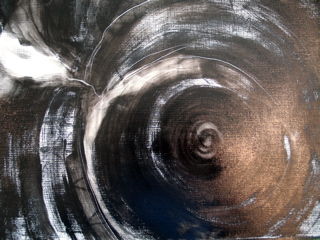
[one of the pieces from the workshop]
next month's workshop is "not just a pretty face," our first 2-day workshop! the first time we hosted it was a lot of fun and we all made a lot of progress, but it was a litle overwhelming for first-time painters. so we decided to give people plenty of time to study the masters the first day, create rough drafts & get comfortable with the materials, then dive into the final portrait the next day after a night to sleep on it. i know i work better that way, anyway!
posted by gl. | permalink | categories: classes & workshops
S - The Slivener
by sven at 8:00 am
Reprinted with permission from Professor Ichbonnsen's Monster Month blog.
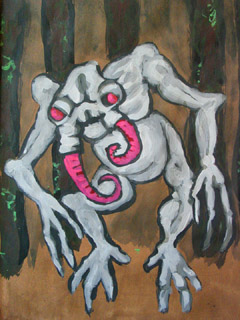
The Slivener is a twelve-foot-tall giant living deep in the forests of Kazakhstan. It is humanoid, has paper-white human-like skin, and seems to be nocturnal.
Not enough is currently known about the animal's biology to properly classify it. In some respects it is like a great ape, but in others it is more like a frog or the common housefly.
The most remarkable thing about the Slivener is its tongue. At first glance, it seems that the creature has pink, writhing tusks. However, it turns out that this is actually a single organ that protrudes from two facial orifices.
Bafflingly, the enormous snake-like tongue is unattached to the rest of the organism. It is able to slide back and forth between sides of the creature's face, always becoming longer on one side and shorter on the other.
The leading explanation for this is that the tongue is actually a separate, symbiotic animal. If so, we are looking at a truly unique evolutionary partnership.
One must ask: Can the tongue survive independently if removed from the Slivener? And if so, for how long?
Initial experiments aimed at answering these questions have proven... ill-advised. Further research -- and further researchers -- will be required.
posted by sven | permalink | categories: bestiary
October 21, 2007
trixie, the 10th muse
by gl. at 8:48 pm
trixie is long overdue for an update! the photo below is a sign from "trixie's," a hair place next door to the little red bike cafe. tlrbc makes wistfully good maple bacon ice cream, but everything there is really quite delicious.

[how could i resist this sign?]
but i've been wanting to write about this since i first saw it mentioned on her blog: shu-ju made a gocco print featuring trixie! it's part of her unofficial "quirky delights in portland" series, the other of which is about the toy horses attached to the old horse rings.(btw, shu-ju was just mentioned in the new york times magazine as a gocco expert in their article "the cult of gocco". go shu-ju!)

[make words erupt like a big cabbage?]
i was blessed with a copy of the print when i went to see shu-ju today during the open studios tour today (more of that in a later post!). when i got out to trixie someone had arranged all her poetry magnets on one side onto the rear door.

[thank you, shu-ju!]
AND... it pained me to have to wait till now to write about it, but bridget's gotten her poetry car up and running now, too! she calls it the "blank canvas" and has already had her first spontaneous poem. yay, bridget! i'm so excited for the poetry cars of america! we've got to get a better name: the automotive poetry association? the poetry transportation society? iambic odometer?

[make time for more love or play]
posted by gl. | permalink | categories: trixie
R - The Rasch
by sven at 8:00 am
Reprinted with permission from Professor Ichbonnsen's Monster Month blog.
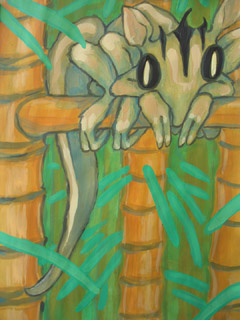
The Rasch is a six-legged marsupial that lives deep in the bamboo jungles of China. It is named after the German explorer who first brought news of it to the Western world in 2006. Strangely, Chinese cryptozoologists don't seem to have been aware of its existence before then.
The animal is primarily arboreal, and has a long tail that helps it keep balance as it leaps from tree to tree. The fur is predominantly light gray, with three distinctive black stripes on the head. Its eyes are often said to be "flashing"; they are usually so dilated that they appear entirely black -- except for when light reflects off the retinas and they seem to glow (much like a cat's eyes at night).
The Rasch is highly animated. It has a metabolism that is in over-drive. During the course of a 24-hour period it never sleeps. It is in constant motion seeking out flying insects, which are its food. Every action is fast, alert, and precise.
The price for life on fast-forward is an early grave. The Rasch is only conscious for three weeks. At the end of this period, it buries itself deep in a burrow and goes into a comatose state -- which it will remain in for the rest of its life, approximately 15 years more.
When the Rasch goes dormant, it takes its offspring with it to this "grave". The several young it has in its pouch will spend the next decade slowly developing -- before bursting to life for their own brief period of consciousness.
One must wonder: Sleeping for almost 25 years of its existence, what does a Rasch dream about?
posted by sven | permalink | categories: bestiary
October 20, 2007
artist's way guided intent (october) & misc book arts
by gl. at 8:38 pm
update 10.21.07: updated the planisphere link. thanks for catching that, sven!
two (!) tuesdays ago michaelmas & i went to the "vamp & tramp" trunk show at 23 sandy, which is a stunning collection of artist's books travelling around the country. michaelmas was impressed with "true to life" by julie chen. i loved a book called "read" whose pages were initially red but would turn white with exposure to heat, so while holding it and reading the primary story, another story would be revealed beneath it.
--*--
the next day, wednesday, was the october guided intent here at the studio. the rainy season prompts us to turn inward, which is a good excuse to literally try to "find yourself" by creating a lifemap. lifemaps are a way to visually explore relationships between the people, places and events that have been important to you.
in what i think is a studio first, bridget wrote about her lifemap on her blog! i've never known anyone to write about these events on their own sites when they leave, so this delighted me. it's good to know this stuff is actually happening and i'm not just making it all up, right? it's good to share the consensual hallucination. ;) plus, it's really lovely to see more insight about a piece develop over time. in addition to lifemaps, this month birch won a metallic marker to gild the edges of autumn leaves, and everyone went home with a wish token in their pocket.
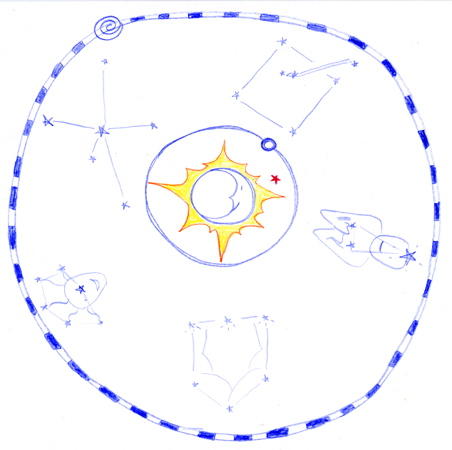
[planisphere: click to see more lifemaps!]
i was obviously hugely influenced by the most recent book i've been reading: dava sobel's the planets. i almost always love astronomy books, but this is beautiful, beautiful, beautiful. i found myself marking almost every page. it's poetry. it's what i want to be when i grow up.
so i created a little planisphere here: since the format is naturally meant to mark change over time, the "constellations" represent variously "ascending" art-parts of my life: theatre, poetry, computers, calligraphy & facilitation. in the center is my "solar system" at the studio. i very much like this concept; there's a lot more to explore here!
--*--
i still want to write about the open studio/collage night we hosted a couple of nights ago, but the next studio event is another guided intent: "possibility," where we'll use a variety of fortune-telling tricks as writing prompts. we'll create poetry using coins, cards, cookies & tea leaves!
then we'll host our first 2-day workshop: not just a pretty face. we hosted this as a 1-day workshop last time and decided there was so much to cover it would be better as a 2-day workshop, so you'll have plenty of time to study the masters and create rough drafts the first day, then come back refreshed and ready to dive into your final painting the next day!
posted by gl. | permalink | categories: artist's way, exhibits & events, printing
the science of monster month
by sven at 12:00 pm
I've been looking into the Prof's claims -- and there's more truth to them than I would have initially thought!
Using wikipedia.com as an easy place to begin my research, I've dug up a fair amount of supporting evidence... And the info that I'm finding is pretty interesting in and of itself. I'd like to share some of the more remarkable bits that I've found here.
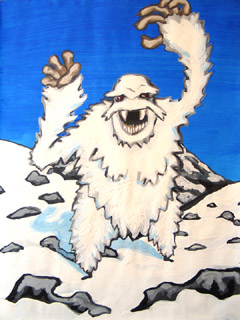
It really rubbed me the wrong way when Ichbonnsen claimed that Jane Goodall believes in Sasquatch... But it's true!
Sasquatch
In a 2002 interview on National Public Radio, Jane Goodall first publicly expressed her views on Bigfoot, by remarking, "Well now, you'll be amazed when I tell you that I'm sure that they exist... I've talked to so many Native Americans who all describe the same sounds, two who have seen them. I've probably got about, oh, thirty books that have come from different parts of the world, from China from, from all over the place...."
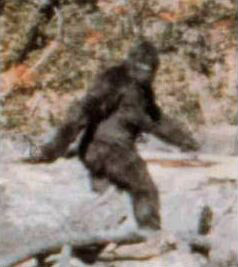
The Prof mentioned that Littlefoot is related to "Gigantopithecus." Check this out:
Gigantopithecus
Gigantopithecus was a genus of ape that existed from as long ago as five million years to as recently as 100 thousand years ago in what today are China, India, and Vietnam, placing Gigantopithecus in the same time frame and geographical location as early hominids such as Homo erectus. The fossil record suggests that the Gigantopithecus species were the largest apes that ever lived. [...]
Based on the slim fossil evidence--primarily huge molars nearly one inch square recovered from Chinese traditional medicine shops, but clearly genuine - Gigantopithecus likely stood about 3 metres (9 feet) tall and weighed from 300 to 500 kg (660 to 1100 lbs.). This is two to three times larger than modern gorillas, although its closest living relatives are the orangutans.
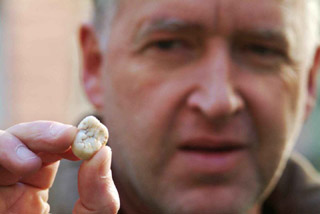
Ichbonnsen says that Littlefoot lives on Mount Shishapangma...
Shishapangma
Shishapangma (officially: Xixiabangma) is the fourteenth highest mountain in the world and the lowest of the eight-thousanders. It was the last 8,000 metre peak to be climbed, due to its location entirely within China and the restrictions on outside visitation to the region imposed by the Chinese during the 1950s and later.

It makes sense to me that a "cryptid" could stay hidden there for a long time. Mountain climbers aren't going to pay as much attention to the fourteenth highest mountain, I imagine. And given China's control of the area, it's going to be more difficult to get access to the place. The Prof did mention that the initial evidence for the creature had to get smuggled past Chinese officials...
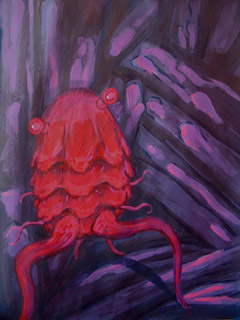
The Prof says that the Grrrheart lives in a deep cave, which was accidentally opened up by coal miners. I'm thinking to myself, not everywhere in the world has caves -- let's check the geological accuracy of this claim.
Cave Research in India
In India, biospeleological research is still in its infancy. Although there are thousands of caves in this country, research work that is being carried out currently is restricted to very few cavernicolous taxa. The state Meghalaya of India is famous for existence of maximum caves.
OK, so I guess Meghalaya really is a plausible location for a cave to be found. But what about coal mining? It's not like you can find coal mines just anywhere...
Meghalaya
Meghalaya is considered to have a rich base of natural resources. These include minerals such coal, limestone, silimanite, Kaolin and granite among others.

Oh. Guess that part of the story checks out OK...
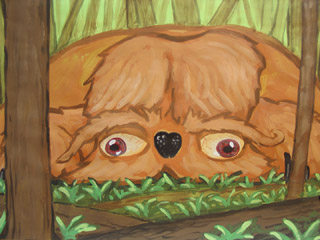
Ichbonnsen made this outrageous claim about North Korea digging tunnels underneath the Demilitarized Zone into South Korea. You've got to be kidding!
Third Tunnel of Aggression
The Third Tunnel of Aggression is a tunnel under the border between North Korea and South Korea.
Only 44 km (27 mi) from Seoul, the Third Tunnel of Aggression was discovered in October of 1978. It is 1.7 km (1.1 mi) long, 2 m (6.5 ft) high and 2 m (6.5 ft) wide. It runs through bedrock at a depth of about 73 m (239.5 ft) below ground. It is apparently designed for a surprise attack on Seoul from North Korea, and can easily accommodate a full division per hour along with their weaponry. A total of four tunnels have been discovered so far, but there are believed to be up to ten more. South Korean and U.S. soldiers regularly drill in the DMZ in hopes of finding more. Its description as a tunnel of aggression was given by the south, who considered it an act of aggression on the part of the north. North Korea tried to downplay the shaft, officially declaring it part of a coal mine. Black "coal" was painted on the walls to help confirm this statement. Additionally, observed drill marks for dynamite in the walls point towards South Korea. Photos are forbidden within the tunnel, which is now well guarded. The South Koreans have blocked the actual Military Demarcation Line in the tunnel with three concrete barricades.
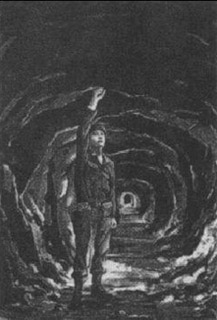
Whoa. OK, that blows my mind.
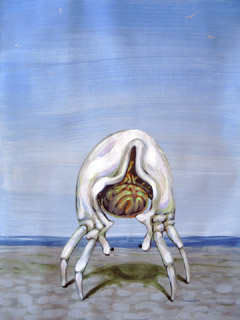
Yesterday's monster supposedly lives on a big Russian island that used to be used for nuclear testing. That ought to be easy enough to check out...
Novaya Zemlya
Over its entire history as a nuclear test site, Novaya Zemlya hosted 224 nuclear detonations with a total explosive energy equivalent to 265 megatons of TNT. For comparison, all explosives used in World War II, including the detonations of two U.S. nuclear bombs, amounted to only two megatons.

Sure enough -- it's real!
Obviously none of this proves that the Prof isn't making up the creatures he describes. But if they are fictional beasts, then he certainly seems to be going out of his way to make sure their back stories hold together.
I still have my doubts... But I'll confess, Ichbonnsen is opening up my horizons a bit.
I live a cozy little existence in an American city, spending my days making art in our studio. It's easy to feel like this is all there is. But the more I look into the world of "Monster Month", the more I realize that the world is really a very big -- and often genuinely strange -- place!
posted by sven | permalink | categories: bestiary
Q - The Quillaupus
by sven at 8:00 am
Reprinted with permission from Professor Ichbonnsen's Monster Month blog.
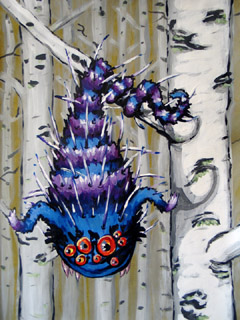
The Quillaupus is native to New England, where it is usually found amongst woods of birch trees. It is furry, with blue and purple stripes. This makes for terrible camouflage -- which is presumably why it evolved to arboreal existence.
The animal has many sharp quills -- and many sharp eyes for sighting its prey. Its method of attack: the prehensile tail loosens its grip on the tree branch where the creature hangs, and the Quillaupus simply drops down upon its victim from above.
The typical Quillaupus is approximately the size of a raccoon; it preys primarily upon squirrels and birds. However, there is record of one Quillaupus that grew large enough to swallow a grown man in one fell swoop. Luckily for this man, the beast's teeth became lodged in the soil, and he was able to dig his way out to safety.
posted by sven | permalink | categories: bestiary
October 19, 2007
professor ichbonnsen validated?
by sven at 2:28 pm
OK, I'm a little freaked out.
Jeffrey's cousin, Raymond J. Legrasse, has reported seeing these creatures in the bayou that he calls "Ocean Folk"... And they look exactly like what Professor Ichbonnsen calls "Polycephalic Forg-men!"
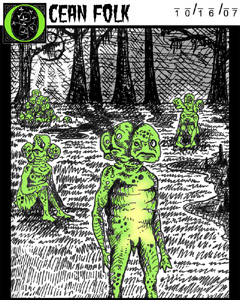
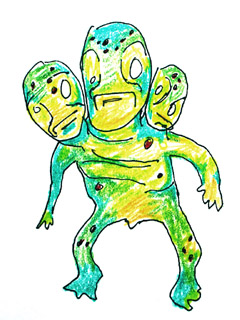
In my initial post about Professor Ichbonnsen I was, shall we say, skeptical.
I mean...Monsters? Really?
But this report about "Ocean Folk" -- it constitutes independent validation! ...Could Ichbonnsen actually be telling the truth?
posted by sven | permalink | categories: bestiary
P - The Pak Mozg
by sven at 8:00 am
Reprinted with permission from Professor Ichbonnsen's Monster Month blog.

"Pak Mozg" roughly translates from Russian to English as "brain crab." It is a species that has recently been found on the southwestern coast of Novaya Zemlya -- an archipelago to the north of Russia, relatively close to Scandinavia.
What makes this crab interesting is that it has an exceptionally large brain, which dangles exposed beneath its dorsal shell. The ventral shell is entirely missing. This makes the crab quite vulnerable to attacks from seagulls -- but it is also, presumably, what makes the prodigious brain development physically possible.
The typical adult Pak Mozg is approximately 10" wide and 14" tall. Its dorsal shell is high and crested, which makes it look somewhat like a helmet. To an extent, this unusual shape helps deflect gulls' attacks.
If the crab is turned over, you can see the web of its nervous system adhered to the shell -- as well as a vestigial stomach lining. The creature seems to subsist solely upon zooplankton, which are captured by a swath of microscopic flagella. Two beady black eyes dangle from protuberances at the front of the shell. The only significant musculature occurs within the creature's four legs.
From 1954 to 1990, Novaya Zemlya was used as a nuclear test site; in the end, it hosted a grand total of 224 detonations. While there is no definite link between the tests and the appearance of the Pak Mozg, the concurrence of these events merits further investigation.
At this point in time, it seems that only a handful of fishermen have taken note of the new species. The ones I've spoken to jokingly refer to it as "the intellectual." When they see gulls flip the crabs over and peck out the brains inside, wry comments are made about the appetites of these "government agents."
Whether or not Pak Mosgs survive into the future is uncertain. On the one hand, they are astonishingly vulnerable to predators -- which seem to enjoy the crabs as a sort of delicacy. On the other hand, the animal displays a high degree of intelligence and adaptability.
It is known, for instance, that the first recorded generation of crabs attempted to lay its eggs on land in the daytime -- and was consequently slaughtered en masse by hungry birds. In the following generation -- several years later -- the crabs appear to have avoided the threat by laying their eggs at night. The most recent generation is reported to have stolen nets from nearby fishing boats -- and actually laid rudimentary traps for the predators.
It will be very interesting indeed to see how this trend develops over time.
posted by sven | permalink | categories: bestiary
October 18, 2007
artist's way: session 4
by gl. at 2:09 pm
now that it's been a month, some of the initial giddiness has worn off, but at the same time, participants are working hard and really looking forward to meeting every week, rearranging their schedules & childcare to make it to sessions. the energy is almost tangible. there's still some fear about competition and comparison, but so far they've been willing to try new things and supportive of each other. this week there was a lot of talk about the portland open studios tour because participants were so excited to be exposed to new art forms, artists and studios.
this week's art activity was one where you write down every single horrible thing your critic says to you, all the reasons it tells you that you can't write, paint, dance, draw, act, metalsmith, etc. then you highlight the thing that provokes the most emotional reaction and let your hand create a movement based on that emotion. you use that movement to draw a scribble over that page of writing. then you squint & turn it around until you can create something out of it. then you pass it along and other participants contribute to that piece, adding something to it or transforming it to protect you from your critic. this sounds like sort of a silly exercise, but it's amazing to see the transformation, and being able to visibly contribute towards the protection of each other really helps bond the group. though the exercise begins somberly, by the end everyone is smiling in delight and surprise.
this is also the session we begin the ever-popular "media deprivation" exercise for a week, which is one of artist's way's most frustrating and rewarding experiences. no reading, tv, music, radio, movies or *gulp* websites/email for the rest of the week. this is meant to balance out your personal consumption versus production. julia cameron thinks you shouldn't read at all, even if you are a student or you're at work, but i don't think media deprivation is supposed to be a punishment or something that makes things worse for you. so i make exceptions for things which are absolutely essential, situations you don't control, and things that can only happen this week that you have already planned.
the goal is to be conscious. awareness leads to progress. so what this means for me is that i'll scan incoming email to see if it's something that needs to be responded to this week, and if not i'll leave it alone. it means i'll ignore the piling queue of rss feeds demanding my attention daily (though i admit to making exceptions for the blogs of personal, local friends). it means i won't read the rest of the planets this week, a book i totally fell in love with while i was traveling in england. and it means i'll try to be very good about doing more, listening to my own voices and desires instead of relying on the influences of others.

center (power): a well of light bursting through rocks like a volcano. it's surrounded by some stars i bought in england.
music: adam hurst's passages, which i bought immediately upon hearing him play at the 100th monkey opening about a year ago. he also plays on a streetcorner during last thursday on alberta. he's really, really, good.
posted by gl. | permalink | categories: artist's way
O - The Opium Gore Golem
by sven at 8:00 am
Reprinted with permission from Professor Ichbonnsen's Monster Month blog.
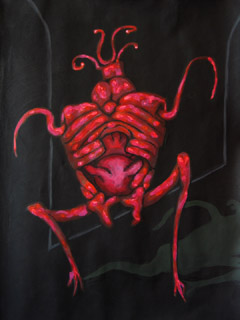
The story as it's told is this: The most powerful and vicious drug lord in Afghanistan captured and enslaved a wizard. After suffering hideous torture, his body and will broken, the wizard finally consented to do his captor's bidding -- to summon up a commando of demon soldiers. The Gore Golems' bodies were constructed from the entrails of a hundred slaughtered enemies, and then animated by each being fed a portion of the wizard's own soul. The grizzly monsters now serve as the drug lord's personal body guard. They are unstoppable in battle; even the bravest man is paralyzed with fear when confronted by their demonic visage.
The truth of the matter is more mundane -- yet no less strange.
The "Gore Golem" is a semi-intelligent, quasi-insect species imported from the deep caverns of Mars. It is believed that six are currently on Earth, and it is true that they are in the possession of an Afghan Opium cartel.
The creature -- whose proper name is unknown -- is a horrid sight to behold. It stands between eight and nine feet tall. The barrel chest has two overlapping ribcages, and an exposed double-stomach digestive system. The thing is covered in grizzly, glistening shell armor -- which sweats blood, so that it's constantly coated with a wet red sheen. It is bipedal, walking on skeletal legs that somewhat resemble those of a grasshopper. The arms are dangerous whipping tentacles. The mouth is concealed in a thick, stump-like neck -- which is guarded by four miniscule eyes at the ends of long, prehensile stalks, that look quite like writhing worms.
"Gore Golems" are not intelligent enough to act as independent mercenaries; their mental capacity is similar to that of a trained horse. However, the animals are deeply susceptible to hypnotic suggestion. By entering a drug-enhanced meditational state, human handlers are able to command the "Golems" almost as if they were extensions of their own mind.
Indeed, over time as the telepathic bond between handler and animals increases, the human becomes able to control them from great distances -- even when they are miles away and out of sight. Given the tactical advantages this presents, drug lords are prone to choose their best and brightest soldiers to manage the Martian beasts. But, the power that the "Golems" grant is not without a price. Human beings who attempt to control these terrifying instruments of death are quickly drained of their mental and physical strength; no master has ever lasted more than six months.
When the handler dies -- eyes wide open, mad and staring -- the "Golems" go into a wild frenzy, killing and destroying everything in their path. Recapturing them and putting them under human control again is a difficult feat, always accompanied by loss of life.
Among certain opium-trafficking drug lords, possession of the "Golems" has become something of a status symbol. More than once, one of these men has ruthlessly executed a rival and tried to steal the beasts for himself. It is rumored that during a botched attempt at theft, one of the six animals escaped, and has since been running amok somewhere in the Hindu Kush mountains.
Cartel use of these creatures violates both international and interplanetary law (United Nations special code). My "foreign contact" has hinted that a mission may be afoot on his end of things to deal with the problem -- but details beyond this are not forthcoming.
A last detail, which I am reluctant to mention. Beyond the sheer physical power of the "Opium Gore Golems", and the undeniable psychological impact that they have on their foes, the creatures are also valued for their detachable shadows. When commanded to, the animal goes into an inscrutable dormant state, and its shadow rushes off from battle to report to its human master. I have witnessed this with my own eyes... And while I have no explanation as yet for how such a thing is possible, I continue to insist that it cannot be "magic."
posted by sven | permalink | categories: bestiary
October 17, 2007
artist's way: session 3
by gl. at 4:06 pm
the third session of artist's way was right after i got back from england and was, in fact, one of the reasons i came back so early. if the trip would have happened later on, i might have skipped a week and stayed longer in england, but skipping the third session is too soon, since the first four sessions are primarily about developing confidence in the group and trust in the process.
the art exercise was a process i call "love letters": some people see the artist's way as confronting their demons or getting down to work in a grim sort of way. but i want participants to start from a position of strength and love and power, so i really enjoy this exercise. i took an izone photo of some part of themselves they wanted to represent as a self-portrait. then they wrote down everything they liked about themselves, then wrote a poem about it & sharing it. as each poem was shared, each person in the group wrote a 1-line response to it and passed it to the writer. then they're all collaged or decorated onto a card to post at home. it sounds a little silly, but it really works: hearing other people validate, affirm and enhance the things you like about youself is a very powerful experience.
i wish they still made izone film: mine has become very unpredictable and large blobs of undeveloped areas will appear, in addition to shifting the hue fairly red. why did you give up on us, polaroid? i may have to figure out another way to do photos; i really enjoy using them in activities, but without a fairly immediate way to print them, it's not very useful. normal polaroids are much bigger than i'd want.

center (identity): a tray full of chestnuts with one shining candle amongst them. i love chestnuts; they feel like the harbringers of fall.
music: the upbeat moby songs from play, 18 and everything is wrong. but one of the participants brought the eels' "i like birds" to play as part of her checkin and we got up & danced.
posted by gl. | permalink | categories: artist's way
From India: The Grrrheart
by sven at 8:00 am
Reprinted with permission from Professor Ichbonnsen's Monster Month blog.

The Grrrheart looks like a red jellyfish with four strong tentacle legs. The average specimen is approximately 2 feet tall, and has two eyes on stalks at the top of its body. The body appears to be composed of three overlapping "caps," from which lesser tentacles protrude. The entire animal is somewhat translucent.
The only known examples of this species were discovered in 2007 in a deep cavern in the Indian state of Meghalaya. They are apparently amphibious, being equally at home on land and in the water. It is hypothesized that they subsist on cave crickets and fish -- although evidence to support this idea has yet to be gathered.
Grrrhearts are profoundly malleable. They are able to travel quickly through cracks in the stone that are no more than an inch in width. It is unknown whether this is a prehistoric species that became trapped underground far in the past, or if it is more closely related to modern day jellyfish -- possibly even going back and forth between the caves and outside bodies of water. The fact that the animal is not blind lends some support to this second possibility.
The Grrrheart lives in large communities. When one animal is threatened, it lets out a warning cry -- which sounds much like the furious growling of a small dog. Dozens of Grrrhearts will rush to its aid.
Despite this fearsome first impression, however, the Grrrheart seems to have a generally non-aggressive, even playful nature. When gathered all together, great numbers of Grrrheart have been observed apparently "dancing" with each other, simply for the pleasure of it.
posted by sven | permalink | categories: bestiary
October 16, 2007
toby's travels: greenwich, england
by gl. at 11:15 pm
i'm so glad sven & the professor have been so prolific in my absence! toby & i went to england at the beginning of october and then leapt into a week's worth of art events & announcements, which i am finally just caught up enough to be able to write about. so expect even more scarlet letters over the next week!
toby's only been on one major trip, but it turns out he loves to travel. we went to england to see the completion of expedition 360, the first circumnavigation of the world via human power. i've been involved with them since i lived in colorado! unfortunately, the event overlapped the hp lovecraft film festival, so toby decided he wanted to come and keep me company. this is the first time i've missed the festival since i moved here!
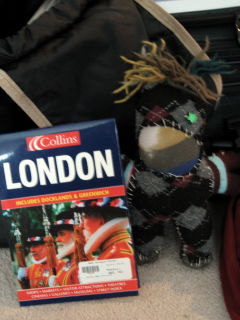
["I'M GOING TO LONDON!"]

["GOODBYE, NINA!"]
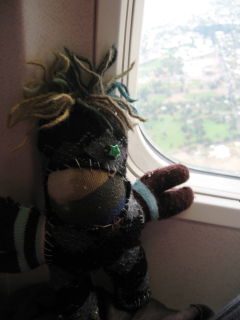
["ARE WE THERE YET?"]

["I LOVE EMAIL! LOOK, IT'S SOMETHING FROM SVEN!"]
we were only there for a few days, but we tried to do a lot in a short amount of time. we went to the british library (unfortunately, they don't issue passes to sock creatures), the london eye, the greenwich foot tunnel, an unanticipated tour of the isle of dogs, the royal naval college, greenwich park, the royal observatory, the pavilion teahouse, and greenwich market (similar to our saturday market). though i was non-plussed at the london eye, i think toby liked it because he was so high up. i had to keep a close eye on him, though; one of the first things i did was almost lose him on the Circle line. :(

["LET"S GO!"]

["OH, GOOD! YOU FOUND ME!"]

[the london eye]

["EVERYONE IS SO SMALL LIKE THIS!"]

["I LOVE COTTAGE PIE!"]
the next day jason arrived with his boat, moksha, at the place he began this journey 13 years ago, at the prime meridian in greenwich. lots of people were there to welcome him home. after the ceremony there was a big party at the river that was a lot of fun, too. i had to take toby back to the hotel before he got too tipsy, though.

["OH! THEY'RE OPENING THE GATES!"]

[toby's pointing to my name on the boat]


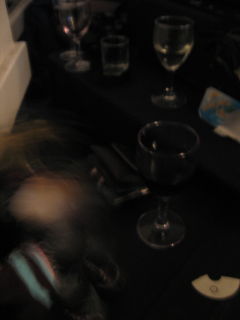
[whoops: time to go, toby]
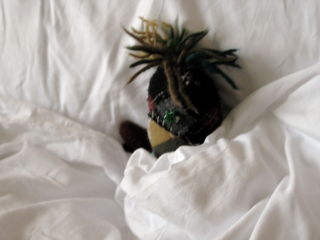
[toby had to sleep in the next day]
i was proud to have the opportunity to watch history happen: congratulations, jason! and we both had a really good time in greenwich. toby thought england quite suited him: he thought everyone had funny accents, but they were kind & polite. one of the elder british ladies at the x360 ceremony said, "i like your poppet." so i think there would be a place for him there if we didn't love him so much here!

["WE CAN GOES HOME NOW PLZ?"]

["GOODBYE, LONDON!"]
posted by gl. | permalink | categories: toby
N - The Noble Shelkay
by sven at 8:00 am
Reprinted with permission from Professor Ichbonnsen's Monster Month blog.
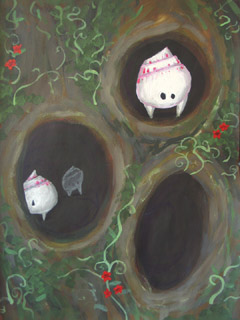
The Noble Shelkay is sort of a half-onion, half-periwinkle, half-rose creature. It lives in the most ancient of forests, building nests inside of enormous, mossy old trees.
Noble Shelkays live in small colonies with their own kind, eating flowers. They appear to co-exist quite harmoniously with the birds, mice, and moths that also share their tree-homes. The creatures seem utterly content; only on the rarest of occasions will Shelkays venture away from the nest.
The Noble Shelkay has a pretty chirping voice. The sing-song sounds it makes may in fact be a language -- but as of yet it has proven incomprehensible.
posted by sven | permalink | categories: bestiary
October 15, 2007
M - The Mountain Howler
by sven at 8:00 am
Reprinted with permission from Professor Ichbonnsen's Monster Month blog.
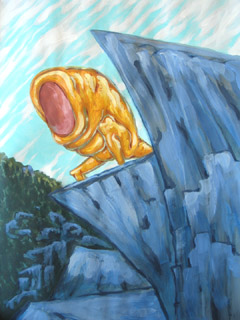
The Mountain Howler is native to Canada's Yukon Territory. It looks rather like an enormous yellow slug with two legs and a cavernous mouth.
The Mountain Howler is typically 2-3 feet in length. It consumes moss and lichen as it climbs sheer mountain cliffs. The Howler is distantly related to gastropods; however, unlike snails, its segmented shell grows internally -- providing it with a pseudo-skeleton. The rigid "legs" act much like pitons, assisting the animal during its climb.
The creature has no eyes to see with. However, it does have an excellent sense of hearing. When it comes time to mate, Howlers announce their presence to one another with an echoing breathy call, which sounds quite similar to a howling wind.
Like slugs, Mountain Howlers are hermaphroditic but need to come in contact with another of their species to accomplish fertilization. Also similar to slugs, concluding mating often requires apophallation.
posted by sven | permalink | categories: bestiary
October 14, 2007
L - The Littlefoot
by sven at 8:00 am
Reprinted with permission from Professor Ichbonnsen's Monster Month blog.

The Littlefoot is a white-haired carnivorous mountain ape indigenous to the Himalayas. Like the North American Sasquatch, this animal is an evolutionary descendant of Gigantopithecus -- a 9-foot-tall ape that lived as recently as 100 thousand years ago in China, India, and Viet Nam. At 12 feet tall, the Littlefoot now claims the title for largest ape ever to have walked the Earth.
Despite living in the same region, the Littlefoot bears no relationship to the mythical Yeti. Whereas notable primatologists such Jane Goodall have been convinced that Sasquatch exists, there is a consensus among serious scientists that the Yeti is a product of folklore and hoaxers.
However, that said, there are some important distinctions that must be made. "Yeti" is a catch-all moniker for several supposed animals, which include the Meh-Teh (the "classic" Yeti), the Teh-Lma (a three-foot-tall frog-eating Yeti), and the Dzu-Teh (a giant half-bear, half-ape creature, which walks on all fours). When people discuss the Yeti, it is almost exclusively the Meh-Teh that receives their attention.
My own research confirms that the Meh-Teh is most likely a product of the imagination... But the Dzu-Teh is quite real. It is what the Littlefoot eats.
The Littlefoot has several interesting adaptations that have preserved its anonymity for so long -- leading some to say that the beast is actually unfilmable.
First of all, there are its feet. In stark contrast with the Littlefoot's huge body, it has tiny little flat feet -- which make footprints easily mistaken for those made by a human wearing shoes.
Secondly, the animal lives in deep ice caverns, and only comes out to hunt during severe, near-blinding blizzards. Thus, eye-witness sightings are profoundly unlikely -- and the winds quickly obliterate the already misleading tracks that it leaves behind.
Thirdly, the Littlefoot is an extremely fastidious creature. When it kills its prey, nothing is left behind. It is careful to bring every bit of the Dzu-Teh carcass back to its lair. I have been lucky enough to get a glimpse of the ancestral caverns -- which after so many years, are now like bone cathedrals, meticulously decorated with thousands of old skeletons.
My having finally been able to track down a Littlefoot tribe's cave is almost entirely thanks to another man's misfortune. Three years ago, a fellow cryptozoologist became lost during a blizzard on Mount Shishapangma. He was tracking a Dzu-Teh -- but little did he know that a Littlefoot was just behind him, following the same trail. Camera in hand, he was about to photograph his "Yeti" -- when the Littlefoot struck...
But, just at that moment, an avalanche came tumbling down the mountain and took the lives of all three! Neither the researcher, the Dzu-Teh, nor the Littlefoot were ever found -- but miraculously the camera survived intact.
The story of how the camera came into the hands of the Chinese authorities, got smuggled out of the country, and then found its way to me -- is too involved to tell here. However, I would be remiss not to mention that there is a small movement afoot to rename the Littlefoot after the researcher who died discovering it: "Mullins' Yeti."
Despite my protests that the Littlefoot is an unrelated species, I expect sentimentality will win out and the name will stick.
posted by sven | permalink | categories: bestiary
October 13, 2007
K - The King Shielyana
by sven at 8:00 am
Reprinted with permission from Professor Ichbonnsen's Monster Month blog.
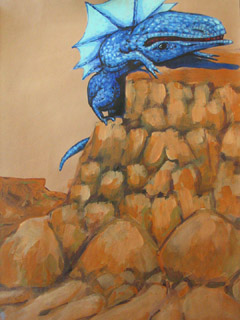
There are several varieties of Shielyana, including: the Dwarf Shielyana, Zompire Shielyana, Emerald Shielyana, and King Shielyana. Of these, the King Shielyana is the largest and most majestic -- being approximately 50 feet long and covered with shining sapphire-blue scales.
Shielyanas are essentially a form of land whale. All cetaceans (whales, dolphins, and porpoises) are descendants of land-living mammals; Shielyana aside, their closest living relative is the Hippopotamus. In a moment of evolutionary indecision, after having returned to the oceans where all life began, Shielyanas decided that life on land really was better after all. Going from one extreme to the other, the Shielyana's aquatic forebears moved as far inland as possible and became desert dwellers.
The King Shielyana is native to the Sonoran Desert, with the majority of specimens being found within Arizona's state borders. Whereas most desert animals find shade during the hottest part of the day, the Shielyana thrives in the heat, and seeks out all-bright locations. The animal regulates internal temperature by raising or lowering its webbed dorsal fan.
Instead of teeth, the King Shielyana has baleen plates growing from its upper jaw, which allow filter-feeding. The animal's diet consists primarily of pollen and air-borne desert krill.
Shielyanas lead a solitary existence until it comes time to mate. Once they have a found a suitable partner, they spend the rest of their life traveling as a pair. The animal typically bear two young per litter.
posted by sven | permalink | categories: bestiary
October 12, 2007
HPLFF drinking game
by sven at 9:00 am
On the last day of the 2007 H.P. Lovecraft Film Festival, I said to myself: carpe diem!
I've been fantasizing about creating an HPLFF drinking game for two years now... So in the last half hour before heading out to the fest, I assembled my notes into the following document. I made something like 40 copies, and distributed them to the theater-goers.
I'm looking forward to putting together an even better version for next year.
THE H.P. LOVECRAFT FILM FESTIVAL DRINKING GAME
by Sven Bonnichsen, 2007
Lovecraftian cliches. We keep hoping for better films... But even when the films are laughably bad, we love 'em despite ourselves. Here's a game to help get you through some of the more unnameable cinema.
Warning: may cause alcohol poisoning. (In the context of the HPLFF, I recommend replacing shots with pieces of candy or popcorn.)
THE BIG GREEN GUY
someone says: Cthulhu
someone says: ftagn!
someone says: R'lyeh
a single tentacle reaches from offscreen
crazy rant mentioning names of 3+ Elder Gods
READING IS BAD FOR YOU
evil book
someone says: Necronomicon
we see hand-drawn demons inside book
character finds the Necronomicon just lying around in someone's house
character goes insane after reading book
interior of a college library
someone says: Miskatonic
HUMAN SACRIFICE
hooded robe
a circle is drawn on the ground
worshipping giant demon idol
candles
bonus: 50+ candles
woman tied up, awaiting human sacrifice
boyfriend/husband murders his girlfriend/wife
bonus: girlfriend/wife murders her boyfriend/husband
the end of the world is represented by stock footage of marching Nazis
the end of the world is represented by stock footage of an atomic bomb
the gateway to the Elder Gods' dimension is an actual door in the wall
DOCTOR, CAN YOU HELP ME?
padded cell
hypodermic needle
hypodermic needle used as weapon
a shot of blood hitting the wall
blood splatters onto someone's face
intestines
decapitation
BOO!
woman screams
vomiting in horror
lights turn off menacingly
bonus: the lights in a hospital hallway turn off
a dark silhouette runs past the the camera in the foreground
someone laughs unnaturally long
full moon
I'D LIKE TO WAKE UP NOW
creepy little kid stands staring
recurring dream repeats
time loop circles back to beginning of loop
RUNS IN THE FAMILY
protagonist had a relative purported to practice witchcraft
tunnels under old house
BUT IS IT ART?
faux scratchy black and white
voice-over for entire film
an actor who is at least 10 years too young for the part
bonus: 20+ years too young
out-of-the-box digital lightning effect
the auteur's name appears 4+ times in the credits
bonus: if the auteur's name appears 4+ times -- and is the only name in the credits
hard rock soundtrack during credits
credits say "copyright" at the end, despite use of infringed music
JOYS OF THE FESTIVAL
you see someone from the Church of Satan
have to switch crossed legs because your ass has gone numb
you've forgotten how many years you've been coming
catch a whiff of body odor from someone in the next row
the guy in the row in front of / behind you thinks he's funny
fall asleep during a film
you bump into Cthulhu in the lobby
TIME TO QUIT
"What's wrong, Elwood?"
posted by sven | permalink | categories: exhibits & events, writing
J - The Jrumiglior
by sven at 8:00 am
Reprinted with permission from Professor Ichbonnsen's Monster Month blog.
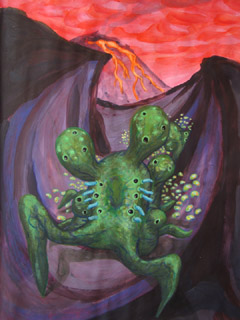
The Jrumiglior is unique in the literal sense: only one such animal currently exists on Earth.
It is non-terrestrial in origin, having come to our planet in a meteor approximately 400 million years ago. It is not, however, independently space-faring. Evidence suggests that it was sent here by a second species, as part of a colonization effort.
The Jrumiglior exists in two distinct states: dormancy and activation.
In its dormant state, the animal becomes utterly rigid and its color turns to a slate gray. It is easily mistaken for a surreal stone statue.
Activation is triggered by extreme heat (in excess of 300°F). When the Jrumiglior's environment reaches this temperature, its blood / internal fluids re-liquify, and normal metabolic functions resume.
When dormant, the animal is frozen in a curled up position -- much like a pill bug -- and it is approximately the size of a small car. When activated, it unfurls itself, revealing a form 30 feet in length that is simultaneously reminiscent of a centipede and a prickly pear cactus.
The Jrumiglior has a segmented body. There are ten segments, each with two pointed legs. Internal partitions allow any one segment to be severed from the whole and still continue functioning independently.
Like yeast, the Jrumiglior reproduces by budding. At any particular time, each of the body's segments is likely to have between one and three new "bulbs" growing off of it. The animal is so long-lived, it is essentially immortal. Bulbs develop slowly; there is no record of one breaking off from the main body during its time thus far on Earth. (Given how infrequently the animal has been activated, however, this does not really tell us very much.)
In its activated state, the skin is green, wrinkled, and warty -- rather like a pickled gherkin. Blue vein-like structures are visible beneath the skin. Some of these break through the surface and develop into prehensile tongue-like organs. The creature's dorsal surface is punctuated with beady, jet-black eyes. These begin as cysts, which over time move outward, ultimately erupting through the derma in a largely random pattern.
Much of what we know about this animal's existence -- both on Earth and before coming to Earth -- has been pieced together from archaeology and occult tomes.
The earliest known images of it come from ancient texts that were discovered in Australia. The Jrumiglior appears several times in fragmentary writings attributed to a great race of conical beings, which voluntarily departed from our planet prior to the emergence of dinosaurs.
Images of the Jrumiglior appear again in hieroglyphics that date back to the Triassic Era, which were recovered in the 1930s from a deep, hidden cave in Antarctica. It appears that the creature was kept there in suspended animation for nearly 250 million years. The broken doors of its vault warn of dire consequences for those who would awake the beast. What sort of beings served as guardians, watching over the Jrumiglior for so long? As of yet, science has no satisfactory answer.
It is unclear how the Jrumiglior came into human hands. However, it has been nothing but a curse to those who have tried to possess it. My colleague, Professor Albert A. Zeef, has made an in-depth study of this history -- which I shall only briefly synopsize here...
For at least a thousand years, the dormant beast seems to have been kept in a hidden underground city in England -- whose strange inhabitants ultimately degenerated into cannibalism. From there, the beast was forcibly taken by a certain pre-Christian religious sect, which transported it to the USA -- carrying it underwater through the Atlantic with the aide of a peculiar, blob-like aquatic creature which I am personally unfamiliar with. The Jrumiglior came to reside in a small fishing town in Massachussets, where -- over generations -- the townsfolk have lost their humanity, due to interbreeding with a species distantly related to the Forg.
The last definite location of the Jrumiglior was in New England. A renowned "wizard" stole the beast from the misceginated forg/humans, and concealed it beneath his farmhouse dwelling. Due to an unrelated tragedy, the estate burned down -- and during the fire the animal was temporarily reawakened. This is where the historical record ends.
The Jrumiglior's current location is uncertain -- but humankind has reason to be fearful. Recent re-interpretations of the Australian texts have shed new light on the creature's distant origins -- and its possible future.
References are made to an unknown species living outside of our solar system. Their name, roughly translated: "The Contributors." Apparently Contributors use the Jrumiglior as a midwife to their own young. The beast is mechanically split open and thousands of fertilized eggs are implanted in its central body cavity. The Contributors telepathically imprint programming into the Jrumiglior's nervous system, and then send it out through space to colonize other planets. When the programming is triggered, the animal deposits the Contributors' eggs in their new habitat. Certain secretions from its body jump-start the maturation process, and soon the eggs begin to hatch. Thus, the Jrumiglior serves first as a protective vessel for Contributor eggs -- and then later, when the eggs are exposed and vulnerable, as a ferocious guardian.
From what we can decipher, the trigger which causes the Jrumiglior to deposit the eggs is some sort of alignment of the stars.
During the past year there have been rumors of the Jrumiglior being sighted awake and active near Mt. Etna -- an Italian volcano which is currently erupting. My contacts report that a large centipede-like creature has been spotted emerging from freshly hewn lava tubes... And that it has been seen on the horizon against a sky of fire, looking up -- as if waiting expectantly for some sign.
I for one am profoundly disturbed by the implications. If this creature is indeed the Jrumiglior and it finally enacts its intended purpose, then the extinction of native life on Earth may very soon come to pass.
Yet, there is hope. I have alerted a secret society whose very purpose is to find and contain the "Apocalypse Wurm." Let us pray for their success.
posted by sven | permalink | categories: bestiary
October 11, 2007
2007 HPLFF review
by sven at 9:00 am

So, the H.P. Lovecraft Film Festival happened this past weekend. Had a really good time!
It was great getting to see my teaser in a real theater. But, I've also got notes to remember for next year: When it was shown on the main screen, the aspect ratio seemed off and the text seemed overly jaggy. When I saw it again on one of the smaller screens, those problems didn't seem so bad -- but I really do need to look into how gamma works, because it was definitely a bit too dark. There was no pause afterwards, so people didn't have an opportunity to clap. (Christian was very kind, though, and leapt in with applause the second time around.)
The shorts blocks are always my priority. My top picks:
- A Short Film About John Bolton - Neil Gaiman's directorial debut, retelling "Pickman's Model"
- Frolick - Peter Pan as a cosmic serial killer (really well-acted!)
Also worthy of note:
- Calls for Cthulhu - a call-in show with a plush Cthulhu
- Of Darkness - pre-teen boys read the Necronomicon, and all the lights in the house go out (decent film -- excellent ending)
- The Pit and the Pendulum - high quality stopmo using a silicone puppet -- part of the "Ray Harryhausen Presents" series
- The Statement - "The Statement of Randolph Carter" done with period clothes and pretty decent acting
- Experiment 18 - sequel to "Experiment 17", which fellow HPLFF lifer Christian Matzke showed last year... Nazis re-animating the dead
As for the feature films, John Carpenter's The Thing and In The Mouth Of Madness were satisfying romps. I didn't get to see either Cthulhu or 9 Lives of Mara -- but Wish Baby and Nobody were exceptionally good.
I'm particularly enthusiastic about Nobody. This and Primer are the two best time travel stories I've ever seen. It was gorgeously shot, had a brilliant script, and mesmerizing actors. I really want to see this film win some awards and get broad distribution! ...Even more amazingly, this is the director's very first film -- and it was shot using a regular DV camera. He simply knew how to work with the machine; e.g. avoiding the color red, shooting with high-contrast lighting -- and other tricks I don't really understand. Watch out for director Shawn Linden -- if all goes well, he's going places!
This was the second year there's been a Lovecraftian live comedy performance. "Chuck and Dexter," those lovable cultists, had me belly-laughing. You wouldn't think it -- but Lovecraftian stand-up is really one of the best parts of the weekend!
Thanks to MPH for coming out to the show. It was also good to see Michael B. and Philip F. there. Gretchin: you may have been in England, but even so, you were always with me.
posted by sven | permalink | categories: exhibits & events, let sleeping gods lie
I - The Ichabod
by sven at 8:00 am
Reprinted with permission from Professor Ichbonnsen's Monster Month blog.
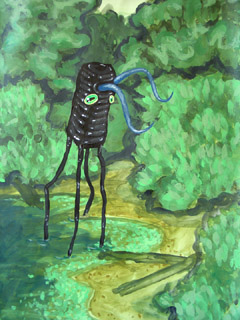
The Ichabod is found only in the deep swamps of Louisiana. Its diet consists solely of Polycephalic Forg-men. Once on the very brink of extinction, there is currently a resurgence in the Ichabod population. Hurricane Katrina helped re-sediment the Forg-men's habitat -- leading to larger than usual clutches of heads. With more prey available, there is hope that Ichabods may yet be able to reestablish themselves.
The adult Ichabod stands approximately seven feet tall. It has long, spindly legs that help it travel more easily through algae-clogged ponds. The legs have neither a skeleton nor exoskeleton; rather, they function purely through vascular tension. The body is boxish, and has roughly the proportions of a milk carton. Two long, prehensile tongues are used for capturing Forg-men. Its pie-plate sized green eyes have slit-like irises. The animal's skin is shiny-black with horizontal ridging, and exudes a thin, clear slime at all times.
The evolutionary origins of the Ichabod species remain somewhat mysterious. Our current best guess is that the creature is a zorn created long ago by a virus that no longer exists. [For an explanation of the term "zorn," please refer to my previous post about the Elysian Zorn.]
The "Insect-Amphibian Transmission" theory proposed by Professor Julian Roche suggests that the Ichabod might even be the result of two successive zorn transformations. The basic idea is that the first virus was associated with a variety of Black Slime Mold. It corrupted the genetic code of an insect related to the Walking Stick. Some time after this, the virus mutated again and was passed on to salamanders -- which ultimately became the Ichabod of today. DNA sequencing for zorns is notoriously difficult -- but Roche's preliminary results do lend some support to this explanation.
The Ichabod takes its name from the fictional character "Ichabod Crane" in Washington Irving's short story, "The Legend of Sleepy Hollow." To understand this, however, first a few words must be said about the life cycle of Polycephalic Forg-men.
The Polycephalic Forg-man is continuously growing and shedding new heads during the course of its lifetime. Heads that have been shed are often left in clutches like eggs, where they develop into new, full-bodied animals. The Ichabod survives by eating these heads.
Previously, while working on an unrelated project, Mr. Bonnichsen created a reasonably accurate illustration of the Polycephalic Forg-man. I have reproduced that drawing here with his permission.

When attacked by a predator, Forg-men are able to shed their current head as a defensive measure. With luck, the predator will be distracted -- chasing after the headless body, which scrambles off wildly. The severed head will ultimately grow a new body; but without a head, the decoy body dies in convulsions several hours later.
This defense is particularly effective against the Ichabod, which by all appearances is horrified by the headless body. Invariably, it runs away, trying to escape the thing... Much like Ichabod Crane fleeing in terror from the Headless Horseman in Irving's famous tale.
posted by sven | permalink | categories: bestiary
October 10, 2007
From Sumatra: The Porpische
by sven at 8:00 am
Reprinted with permission from Professor Ichbonnsen's Monster Month blog.
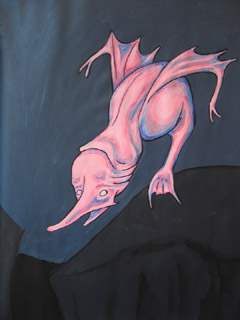
The Porpische is an extremeophile: it lives in deep ocean crevasses, where immense pressures and volcanic heat vents make human exploration extremely difficult. Populations have been discovered off the eastern coast of Sumatra. Whether the species exists in other areas is not yet known.
The Porpische is large -- nearly twelve feet in length. With a long "bottle-nose," the animal looks somewhat like a dolphin. However, it is actually a form of fish -- with gills and a cartilaginous skeleton -- distantly related to sharks.
Porpische have a beautiful full-body bioluminescence. The entire animal glows with a ghostly pink light. When the animal is startled, the light suddenly winks out -- presumably to help hide it from predators. (What sort of deep-water leviathan hunts Porpische is currently a mystery.)
Rather than fins, the Porpische has two bat-like wings at its sides. The impression that the animal is actually "flying" through the water is astonishing. Like a bird that rides updrafts of warm air, it can use these wings to catch an updraft of hot water coming from a volcanic vent and soar swiftly upward. One can imagine that this ability occasionally provides the animal with a means of quick escape when it finds itself in danger.
Porpische seldom come up farther than the mouth of the chasms in which they live. Watching the glowing beasts gently circling back down into blackness, like a spiral of Christmas lights disappearing into the night, one's mind cannot help but be tattooed with a haunting sense of wonder. Myself, I count this experience as one of the most awe-inspiring moments of my life to date.
posted by sven | permalink | categories: bestiary
October 9, 2007
H - The Heartbreak Spider
by sven at 8:00 am
Reprinted with permission from Professor Ichbonnsen's Monster Month blog.
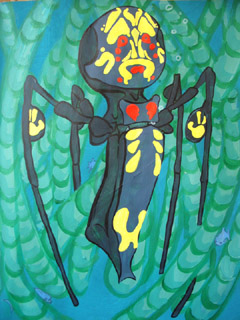
Bright markings on a creature are often nature's way of saying "danger!" Nowhere is this more true than with Indonesia's Heartbreak Spider.
This four-foot-tall aquatic spider is adorned with brilliant yellow and red markings, which bear an uncanny resemblance to a scared human child:
- The spider's proportionally-small and raised abdomen simulates the child's head. Many see weeping eyes and a face in the pattern of the abdomen's markings.
- The cephalothorax lacks pedipalps; instead, there is an exceptionally long and toothy jaw. Markings on the jaw are often interpreted as a human ribcage and pelvis.
- Also unlike most spiders, this specimen has only four legs -- each of which sports a flexible air bladder, with markings on the front two that look quite like hands.
- Adorning the creature's "nose" are two more red markings, which look just like a broken heart.
Heartbreak Spiders consume fish and waterfowl -- but they are particularly suited to snaring human prey. Around twilight, when visibility is poor, the creature comes up from its underwater nest, and lurks half-submerged in the shallows of a slow-moving river...
When a human passes by, the spider goes into spasms, splashing about -- which in the half-dark causes it to look very much like a drowning child. When the passerby attempts rescue, it grabs onto their leg with its powerful jaw and pulls them down to a watery death. The spider is able to stay there underwater for up to two weeks at a time.
Tangentially, it should be mentioned that there is another species involved with the Heartbreak Spider, which enjoys a symbiotic relationship: the Bone Fish. Bone Fish, as one might guess, eat bones. They take no interest in meat from the spider's prey -- but after the bare skeleton has been discarded, they use their sharp little teeth to break it down into digestible chips. No evidence of the victim is left to be found. This deadly partnership has contributed to the spider having remained anonymous for so long.
In the past, a few remote communities have become aware that something is living in the rivers, dragging people to their deaths. An additional "heartbreak" caused by the spider is that in several cases children have simply been allowed to drown, because adults suspected that the child was really a magical "monster" trying to lure them into the water.
The catastrophic tsunami of December 26th 2004 not only devastated the human population -- it also wiped out more than 80% of this spider species. However, three years after the wave, the species is beginning to reemerge -- and in places where it had not been seen before. It appears that the flood waters swept the spiders' eggs up into areas where they have not existed previously... Bringing them into contact with entirely new potential victims.
posted by sven | permalink | categories: bestiary
October 8, 2007
G - The Grimberry Tree
by sven at 8:00 am
Reprinted with permission from Professor Ichbonnsen's Monster Month blog.
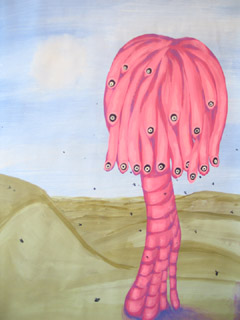
My acquaintance Professor Amberson was traveling recently in the deep Saharan desert along with his family -- when he happened across a Grimberry Tree. This is his how he recounts the experience:
"We're traversing great rolling dunes -- swells like ocean waves in a storm, but made of blistering, dusty sand. We ran out of water a day ago. Our lips are cracked and bleeding. My tongue is a dry, alien thing in my mouth. Death cannot be far away...
But wait! Up ahead there seems to be some sort of tree, bursting from the sand. Surely this must be a mirage, I tell myself -- because the tree is flamboyantly hot pink. But so what if it is a mirage? With nothing to lose, we might as well check it out.
The sweetest smell of honey floats on the air, and the gentle hum of bees fills our ears. It's comical, it's cartoonish: this tree is straight out of a Dr. Seuss story.
And then: the 'happy little tree' lets out a ferocious roar -- like a belching lion.
A pink, slimy frond whips out fast as lightning and grabs my son by the ankle. With demon speed, the tree dashes the boy against the ground repeatedly, swinging him from the ground on the right all the way over its 'head' to the ground on the left and back again. Again and again and again!
The tree sucks Wes -- poor Wes! -- into its canopy, and chews him up with loud crunching sounds. Then: silence. My daughter Polly and I look to each other, stunned.
Just as suddenly, the tree spits out the boy's skeleton like a watermelon seed. Which lands at our feet. Thud."
The Grimberry Tree is a muscular carnivorous plant with slimy pink tentacles in place of leaves. The tree is unable to "walk" per se -- but its root-legs do enable it to stay atop shifting sands and (to an extent) to steer its course as sandstorms reconfigure the landscape around it.
The tree is not sentient -- nor does it even have a "brain," as we understand such things. However, it does have photoreceptors on the ends of many of its tentacles -- which both look and act very much like eyes. These "eyes" interact with its pseudo-nervous system in a way that enables effective attacks on large prey.
For the most part, the Grimberry tree subsists on insects, which are attracted to its distinctly honey-like scent. It also consumes birds when possible -- and as we have seen, equally enjoys human flesh. Typically animal corpses will be dropped from the tree's branches half-digested. The stink of rotting flesh helps to attract more insects. The "bait" doesn't last for long, however. Such debris is soon "washed away" and buried with the shifting sands.
[In case you're curious: Professor Amberson, Polly, and Wes all miraculously survived their encounter unharmed. I may meet up with them "on the road" in the near future. Last I heard, the family was planning an outing to Mount Etna, to take an up-close look at the ongoing volcanic eruptions.]
posted by sven | permalink | categories: bestiary
October 7, 2007
F - The Flightless Goan
by sven at 8:00 am
Reprinted with permission from Professor Ichbonnsen's Monster Month blog.
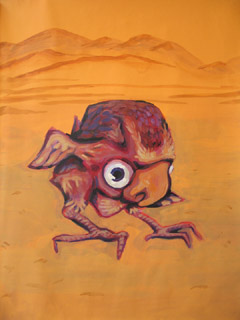
The Flightless Goan is a carnivorous, desert-dwelling bird found in the Mexican state of Coahuila. It is exceptionally fast, and has remarkably keen eyesight.
Standing at two feet tall, Goan hunt small and medium-sized game such as rabbit and coyote. Hunting is often done in groups of 2-4 animals. Their razor-sharp beaks rapidly slice prey into ribbons.
The birds have a distinctive cry -- "moh!" -- which they shriek whenever running. When they pause, the cry stops. It is a curious experience to hear the animal as it stops and starts: Moh! Stop. Moh! Stop. Moh!
Goan, it is believed, are a pygmy version of the quasi-mythical Giant Roc -- a bird allegedly capable of carrying off fully grown elephants in its claws. Recent evidence suggests that such a species genuinely did exist at one point in time, but that it went extinct long before the appearance of Homo Sapiens. The Giant Roc in European and Middle-Eastern mythology -- and the Thunder Bird in Native American folklore -- most probably emerged out of humans' attempts to explain fossil remains.
In essence, the Giant Roc seems to have been a cross between the Pterodactyl and the Archaeopteryx (the earliest known bird) -- but larger than either. It is doubtful that even the largest Giant Roc could have lifted an elephant; prey approximately the size of oxen, however, were not out of the question. Such great birds must have depended upon the existence of huge herds of prey to survive. We can guess that they were very territorial, and that due to this, successful mating was rare.
Given the immensity of their drain on the ecosystem, no one bioregion could support Giant Rocs indefinitely. As food became too sparse, mutations resulting in smaller birds were advantageous. Based on skeletal evidence, it is almost certain that today's Flightless Goan is a direct descendant of the avian megafauna. Indeed, fundamental similarities between the Goan and the Roc are so profound, some have suggested that it is only a matter of time before a random mutation in the Goan genome leads to the rebirth of Giant Rocs in the modern world.
Our collection of fossilized birds is too scanty at present to prove anything -- but perhaps over long periods of time we are seeing a cycle between the pygmy- and giant-sized version of a single bird species. If so, the phenomena would lend new credence to myths about the Phoenix that is reborn from its own ashes.
posted by sven | permalink | categories: bestiary
October 6, 2007
From North Korea: The Giant Mupp
by sven at 8:00 am
Reprinted with permission from Professor Ichbonnsen's Monster Month blog.

The Giant Mupp is a species of dog native to Korea. Early in its lifespan, the animal is indistinguishable from a common street mongrel. However, as it ages, a remarkable difference becomes apparent.
The Giant Mupp lacks the genetic coding that turns off physical growth. As each year passes, it simply gets bigger and bigger. Furthermore, it also lacks the related code that produces senescence -- meaning that there is no significant metabolic deterioration as it ages. Theoretically, the animal could live forever.
Only one factor limits the Mupp: gravity. When it reaches the size of an African Elephant, the sheer weight of its flesh cripples the dog's ability to walk; only by crawling on its belly is it able to move about. As the Mupp becomes even larger than this, it will ultimately become stranded in one spot.
The animal would starve to death at this point, were it not for a very unusual adaptation. The tongue begins to grow at a faster rate than the rest of the body. The Giant Mupp is able to press this organ down into the ground, and begins absorbing nutrients from the soil beneath it. Over time, the tongue actually splits and forks into many branches -- until it resembles nothing so much as a tree's root system.
But gravity always wins. As a Mupp's eyes get larger and larger, they become distorted by their own weight, flattened out. Eventually, the membranes are too weak to contain their vitreous humor, and the dog's eyeballs burst. The Mupp can live on, blinded, but other internal organs will inevitably meet the same fate. Life ends.
Stories have been told of Mupps sixty feet wide and thirty feet tall being mistaken for hills. Animals of this size, however, have not been seen for several centuries -- and likely won't be seen again. It is estimated that the largest Giant Mupps that ever existed lived to approximately 600 years. Few today, however, ever even become noticeably large.
For generations, the meat of Mupp was considered a delicacy in Korea. Due to its popularity, the native population was almost wiped out. Farmers who bred Giant Mupps in captivity harvested the animals at earlier and earlier ages, until little difference remained between the size of the Mupps being consumed and other dogs. The practice of breeding Mupps died out; the few remaining specimens have mostly been assimilated into the general street mongrel population.
Giant Mupps as distinct species lasted somewhat longer in China. During the early dynasties, Mupps were exported to China to serve as imposing imperial guardians. The "Foo Dog" has mistakenly been identified by some as a Chinese representation of the Lion. Not so! As "magic" protectors for homes of the rich, few were entrusted with the truth of the animal's origins -- but I have personally met with certain old families remaining in possession of scrolls that provide enlightenment on this matter.
It has been rumored that there are at least two Giant Mupps surviving within China's borders. It is also likely that there are still some genetically pure Mupps left in Korea, which have escaped into far-flung wooded areas.
posted by sven | permalink | categories: bestiary
October 5, 2007
E - The Elysian Zorn
by sven at 8:00 am
Reprinted with permission from Professor Ichbonnsen's Monster Month blog.
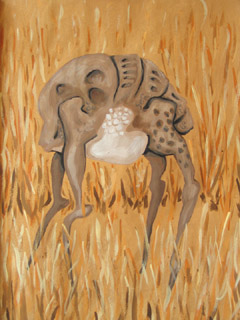
A virus is unable to self-replicate except by invading the living cells of a host animal. Certain viruses are able to significantly re-write their host's genetic code. When this genetic re-coding results in "massive" transformations of the animal's outward form, the resulting creature is referred to as a "zorn." "Zorn" is not a single species, but rather a category of species: creatures whose origin is viral DNA re-scripting.
Zorns based off of giraffe, gazelle, buffalo, elephant, and baboon stock have been sighted with increasing frequency throughout central Africa for the past five decades. It is obvious from their appearance that these zorns share a common viral origin.
The animals have become headless. Their eyes and ears have been replaced with an ultrasonic echolocation system, now located in the frontal thoracic region. The truncated throat has transformed into a loosely musculatured proboscis only capable of dealing with liquified nourishment. The ribcage has reformed into a segmented shell (typically still covered by fur). The dorsal shell is perforated with orifices that excrete a weak acid solution, which the zorns use to dissolve plant materials -- which are then slurped up through the proboscis. The legs and digestive systems of the original animals remain essentially intact.
Fortunately for humankind, this particular zorn-producing virus cannot be transmitted by casual contact. It must be injected directly into a host animal's bloodstream. However, once the animal has become a zorn, the condition is inheritable. All subsequent offspring share the parent's new form... Zorn herds are increasing.
What is the original vector of this viral strain?
With great difficulty, I have tracked the virus back to its source: Martian insect megafauna. These are colossal flea-like creatures, the height of a two-story house. They are omnivores that occasionally enjoy meat -- and they are extremely effective hunters. After capturing their prey, they trap it in a cocooning blanket of slime, and then inject it with digestive juices that slowly liquify their intended meal from the inside out. On very rare occasion, some of the prey have managed to escape. These "lucky" ones became the first zorn of their kind.
It is my belief that there are only two or three of the giant insects on Earth at present. I believe that they were brought to our planet entirely unintentionally, during the course of black market trading between Earth and Mars. Certain foreign correspondents of mine have linked this particular insect species specifically to Elysium -- a large volcanic region of Mars, stretching roughly between 15º-45º latitude and 130º-160º longitude.
Knowing this, the zorn that we are currently seeing in Africa should properly be identified as Elysian Zorn. (Zorn are typically named after the location where their viral mutagen first emerged.)
Because the Elysian Zorn virus is only transmissible via direct injection into the bloodstream -- and because we know the original vector of transmission -- we have an excellent chance of being able to contain this outbreak before it spreads farther... If authorities are willing take action.
However, proliferation of the Elysian Zorn is indicative of a even larger, more insidious problem. Given that the first record of an Elysian Zorn in Africa dates back to 1863, we can reasonably extrapolate that illegal trafficking between Earth and Mars has been going on for at least 150 years.
Contact between the two planets is hopefully still a rare occurrence -- but every instance is a new opportunity for disease and invasive species to spread into environments where they do not belong. Elsewhere I have written about illegal importation of the "Opium Gore Golem" by certain drug cartels... What other dangerous species are already here among us?
posted by sven | permalink | categories: bestiary
October 4, 2007
"lurker in the lobby" book mentions me
by sven at 10:00 am

I've been meaning to write about this for ages... And since I'm trying to encourage people to come to the H.P. Lovecraft Film Festival tomorrow, now seems an apt moment.
Lurker In The Lobby: A guide to the cinema of H.P. Lovecraft is a recent book written by Andrew Migliore (founder of the filmfest) and John Strysik. If you're a fan of the genre, then this is a book that you cannot do without. It reviews essentially every Lovecraftian feature film, TV show, and short that has ever been created.
A page is devoted to Edward Martin III's Dream-Quest of Unknown Kadath, which I had a microscopic role in animating.
The book also mentions Madness from the Sea -- my very first short film, which premiered at the Lovecraft Filmfest back in 2002. The synopsis:
Planets come into alignment, a storm erupts, and Cthulhu appears.
Well said! Accurate, and more succinct than I've ever been. ;-)
If you're interested in purchasing Lurker in the Lobby, I recommend buying it from Migliore directly, at the Arkham Bazaar. The book is also available via Amazon.com and bookstores such as Powell's (here).
posted by sven | permalink | categories: movies
D - The Dark Strider
by sven at 8:00 am
Reprinted with permission from Professor Ichbonnsen's Monster Month blog.
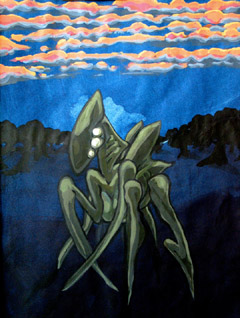
The Dark Strider is clearly insectoid in origin, having six legs and vestigial wings. However, in many respects its form and temperament are strikingly equine in nature. Indeed, seen at a distance and in dim light, the animal is easily mistaken for a wild horse. It stands approximately eight feet tall (6 ft at the shoulder) -- and when it runs, its gait is best described as a gallop.
The front two legs are sharp spears, much like those of a Praying Mantis. Contrary to appearances, however, the Dark Strider is vegetarian. These frightful weapons are used purely for self-defense and grooming purposes.
Most Dark Striders seem to suffer from parasites -- in particular, a translucent, apple-sized grub known as the "Noub." Noubs attach themselves to the Dark Strider's back, typically behind the vestigial wings, where it is difficult for the skewering front legs to reach.
Noubs are a constant source of irritation, as they emit a high-pitched chirruping whine for hours at a time during the night. This noise poses a serious threat to the Dark Strider: predators are often attracted to the sound. Yet, a strong fight-or-flight response makes the animal difficult prey to fell.
The Dark Strider is native to Romania, but is far-ranging in its travels. Following our successful efforts to tag a Dark Strider with a radio transmitter, my colleagues the Quay Sisters have reported back that the animal seems to have a particular affinity for Czechoslovakia. Perhaps this is an ancestral home, where the species returns to breed -- just as salmon instinctively return to their place of birth.
The Dark Strider is a purely nocturnal creature, only venturing out from its murky forest shelters as twilight ebbs into night. It is extremely solitary for most of the year; however, on occasion, a small group will inexplicably gather together in a moonlit glade. During this meeting -- a "forum" as it has been picturesquely termed -- the animals seem to communicate with each other. The purpose of these gatherings remains a mystery.
posted by sven | permalink | categories: bestiary
October 3, 2007
a beautiful hoax: the lovecraft filmfest acceptance letter
by sven at 10:00 am

I've been meaning to share this for a while: the acceptance letter that the H.P. Lovecraft Film Festival sent me for the new Let Sleeping Gods Lie teaser.
I love this!
I think The Hoax is the highest form of fiction. Cinema comes close, creating an immersive fantasy world; but there's always this fourth wall between you and the imaginary place. With The Hoax, however, fantasy breaks out of its cage and invades reality. I suppose it's sort of like guerilla theater in that sense... The artist's dream life can errupt into being anywhere, at any moment.
An elaborate and beautifully crafted Artist's Hoax is different from "viral marketing." It's perpetrated tongue-in-cheek, with a sense of playfulness that invites the audience to play along -- to embellish, even. Viral marketing, on the other hand, is coercive. It's a con job, where shills are planted in the audience purely for the purpose of herding their marks into the slaughterhouse.
[I'm also a big fan of mixing metaphors: the much maligned linguistic mash-up. ...But that's another essay.]
Anyway: Don't forget that the H.P. Lovecraft Filmfest is happening this Friday. Hope to see you there!
posted by sven | permalink | categories: exhibits & events, let sleeping gods lie, writing
C - The Cradle Robber
by sven at 8:00 am
Reprinted with permission from Professor Ichbonnsen's Monster Month blog.
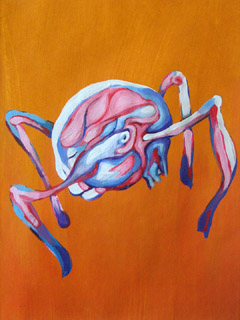
The Cradle Robber is a pale blue, four-legged, spider-like creature.
What is most remarkable, however, is that the animal's carapace is almost exactly the same shape and size as a human infant's severed head. This gruesome camouflage has been to put to good effect by the hunter in its preferred environment: mass graves.
The creature's body is covered by a bone exoskeleton, with exposed muscle groups and vein systems on the sides. Its slimy red eyes and prehensile mouth-fingers are located where the neck of the "baby head" seems to dangle. Indentations on the back of the carapace simulate the baby's mouth, nose, and closed eyes.
Cradle robber populations flourish during times of war or plague. The animals crawl into pits of dead bodies being readied for burial, and then wait patiently for their prey. Bereaved parents searching for lost children inevitably find their way to the graves... And then as the mothers and fathers kneel over piles of corpses, weeping and looking for their offspring, the predators strike.
When plagues are at their height, the animals have sometimes been emboldened to venture into the heart of human communities. Terrible tales have been told of the Cradle Robber that sneaks into a nursery, kills and consumes a child sleeping in the crib, and then waits for the parents to return -- sitting motionless there upon the bloody pillow, as if it were a wet nest.
During periods of peace and human health, the Cradle Robber population shrinks and retreats into dry underground tunnel systems. Clutches of eggs have been found secreted inside both French and Czech ossuaries.
There are large periods of history where the animal seems to be entirely absent from written record. It is possible that the Cradle Robber population collectively goes into a period of hibernation when the environmental factors that support its survival are no longer right.
If so, then we must ask: how does the species wake up again? At this point in time, the leading theory is that the Cradle Robber has a symbiotic relationship with rats -- which also prosper during times of human suffering. It is suspected that there are certain chemical markers in the urine of rats eating human flesh that serve as the wake up signal -- much like the ammonia component of smelling salts.
Evidence of Cradle Robber populations has been found throughout Europe and also the western reaches of the former Soviet Union, reaching back to Roman times. In recent years, rumors have circulated about a subspecies of black-shelled cradle robbers being sighted much farther south, in Rwanda and Darfur. Further investigation is required.
posted by sven | permalink | categories: bestiary
October 2, 2007
LSGL teaser kicks off lovecraft festival!
by sven at 6:00 pm
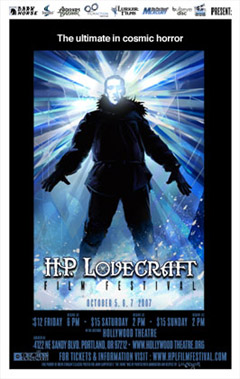
The H.P. Lovecraft Film Festival begins this Friday night... And my new Let Sleeping Gods Lie teaser will be the very first thing shown on the big screen!
Doors at the Hollywood Theater (4122 NE Sandy Blvd) open at 6pm. There is often a long line on opening night, so I recommend arriving early or purchasing your tickets online.
My teaser is the first thing in Shorts Block 1.
Shorts Block 1 shows at 7:05pm Friday night on the Main Screen. It will be shown again at the very tail end of the festival, Sunday night at 10:20pm on the Upper Right Screen. The complete schedule is available at the HPLFF website.
Hope to see you there!
posted by sven | permalink | categories: exhibits & events, let sleeping gods lie
artist's way: session 2
by gl. at 4:45 pm
i was relieved when the weather decided to be kind enough today so we could do the poetry walk, which is an exercise where i do a simple loop around the neighborhood and we write down all the nouns and verbs of the things around us (or what they make us think of). the trick is that you can't use adjectives or adverbs. afterwards, we had 20 minutes to write a poem, though it didn't have to use those words or be about the walk. i love that even though we've all been influenced by the same walk, we write dramatically different poems.
falling
with each step
we are escaping
from our boxes
of wood and metal
and fences can't keep us
from the fields
lined with grass
and fallen apples.we are walking together
but writing alone
each rose glowing red
against its own grey sky.::oct02.2007::

center (safety): calligraphy pens forming a structure in which art can grow, with the stars shining & encouraging from above, about ready to drop in
music: tracy chapman's new beginning
(and now i'm off to england! tally ho!)
posted by gl. | permalink | categories: artist's way, writing
B - The Badogedown
by sven at 8:00 am
Reprinted with permission from Professor Ichbonnsen's Monster Month blog.
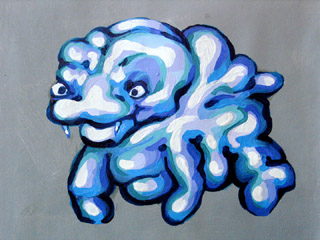
Nearing the end of 2007, the world population of badogedowns stands at approximately 30 animals. The species was believed to have gone extinct in 2005. However, under condition of anonymity, it has been revealed to me that two private collectors have managed to preserve several animals, and are quietly pursuing a breeding program.
The Badogedown is a rubbery, blubbery, gelatinous sort of puppy dog. It is not the result of natural selection, but rather a failed attempt at genetic engineering undertaken during the early 2000s by corporate interests.
Two companies, one in Japan and one in the USA, are responsible for producing the new species. Their intent, it seems, was to capitalize upon the designer toys/urban vinyl movement by producing a living pet whose flesh emulates the texture of shiny rubber toys. They hoped to appeal to the aesthetics of parents who grew up in the 1970s, who would then purchase the pups for their target market: young girls, ages 10-12.
In most respects, the companies' scientists were eminently successful. The Pekinese-sized pooch both looks and feels like a living toy. Furthermore, the Badogedown's character is ideally suited for family environments: its enthusiastic affection and loyalty toward children is truly unparalleled. When the dog is brought home, it bonds to its young new owner almost instantaneously, and the two become immediately inseparable. It follows the child around wherever they go, relentlessly leaping up and happily licking the youngster's face.
Unfortunately, there are two tragic flaws in the animal's make up, which genetic engineers were never fully able to eliminate...
The dog has no ears. As it affectionately assaults its human master, there is simply no way to call it off.
Worse yet, the Badogedown possesses two very sharp fangs. Consequently, in the several test groups of young girls that it was exposed to, the animal's paroxysms of love invariably resulted in serious injury. (Quite unintentionally, on the part of the dog.)
Even after these tragic incidents, it was several years more before the "vinyl love dog" project was finally brought to a halt and the animal population destroyed. It seems that this delay resulted from a peculiar communications breakdown during the international collaboration.
Product testing for the pups was done in the USA; the Japanese project leaders were only able to listen in via teleconferencing. The young girls' screams of terror were misinterpreted as shrieks of pleasure. In Japan, "bad dog, get down!" was believed to be an unknown English colloquialism of affection... Which resulted in the Badogedown's name: a Japanese transliteration of the exclamation that that each and every test subject was heard shouting.
Attempts to file down or mechanically remove the teeth have all been unsuccessful. Likely due to the addition of rodent DNA, the teeth regenerate and continue to grow quickly during the animal's entire life-span. Corporate interests finally were forced to admit failure.
However, ego and soft-heartedness are stubborn traits. There is reason to suspect that the two individuals who have preserved the Badogedown species were in fact scientists who worked on the original "vinyl love dog" project. Facing the prospect of their creations being exterminated and all records erased, I believe that they smuggled out a handful of pups -- and have since continued on with their "labor of love."
My contacts have not been forthcoming with details about where the dogs are currently being kept -- but they assure me that all necessary precautions have been taken to keep the animals safely contained in captivity.
posted by sven | permalink | categories: bestiary
October 1, 2007
A - The Adameve
by sven at 8:00 am
Reprinted with permission from Professor Ichbonnsen's Monster Month blog.
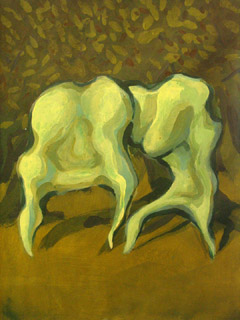
The Adameve is a large, glistening white, maggot-like beast. It has a grossly oversized, eyeless head, and two long facial feelers that are nearly identical in shape and size to the legs.
The creature is bipedal -- yet often gives the appearance of moving on four legs. Being completely blind, it uses the facial feelers to help find its way along the ground, moving them in a sort of "walking" motion.
At maturity the Adameve can stand as much as twelve feet tall. Folded in half as it travels, the dorsal crest will measure approximately six feet up from the ground.
The species is known to haunt certain old, blasphemous orchards in England and western Europe. Primarily nocturnal, for centuries its rambling gait has caused witnesses to mistake this monster for a ghostly couple: a naked man and woman silently dancing together beneath moonlit trees.
This impression, combined with the association with apples, likely explains its name: a conjunction of "Adam and Eve."
To reproduce, the hermaphroditic Adameve injects its eggs into apples growing on the trees -- thus supplying the young with a ready-made supply of food when they hatch. In their early stages, the larva are easily mistaken for maggots writhing in and out of rotting, fallen fruit.
Adameves are extremely territorial. The young (initially numbering in the hundreds) will quickly tear each other apart, competing for dominance. Near the end of the frenzy, the most aggressive children will gang up to kill and eat their own parent. Ultimately, only one animal survives in the orchard.
Based on historical records, it is believed that the species spawns approximately once every hundred years.